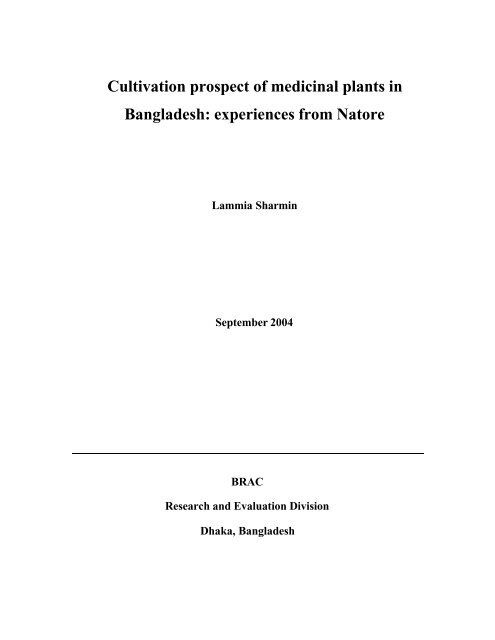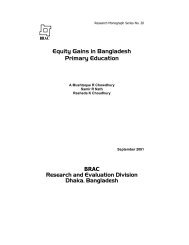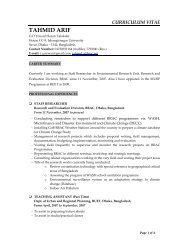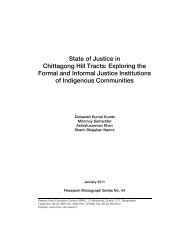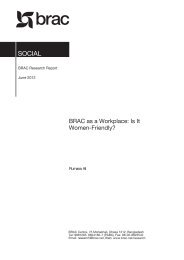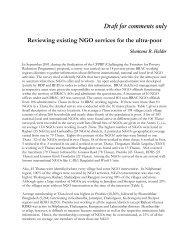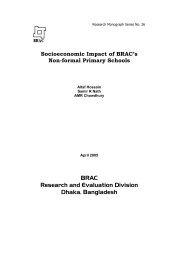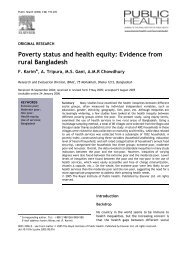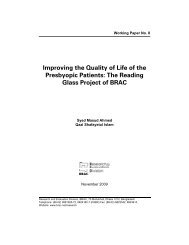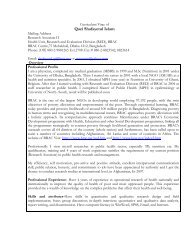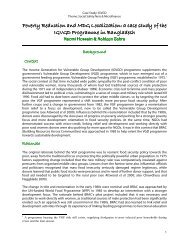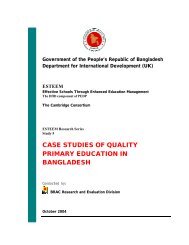Cultivation prospect of medicinal plants in Bangladesh - BRAC ...
Cultivation prospect of medicinal plants in Bangladesh - BRAC ...
Cultivation prospect of medicinal plants in Bangladesh - BRAC ...
You also want an ePaper? Increase the reach of your titles
YUMPU automatically turns print PDFs into web optimized ePapers that Google loves.
<strong>Cultivation</strong> <strong>prospect</strong> <strong>of</strong> <strong>medic<strong>in</strong>al</strong> <strong>plants</strong> <strong>in</strong><br />
<strong>Bangladesh</strong>: experiences from Natore<br />
Lammia Sharm<strong>in</strong><br />
September 2004<br />
<strong>BRAC</strong><br />
Research and Evaluation Division<br />
Dhaka, <strong>Bangladesh</strong>
Table <strong>of</strong> contents<br />
Abstract ……………………………………………………………………………………….……… 2<br />
Acknowledgements …………………………………………………………….. …………………… 3<br />
Introduction …………………………………………………………………….. …………….…….. 4<br />
Glimpses <strong>of</strong> the history <strong>of</strong> herbalism ………………………………………………….……….. 4<br />
Def<strong>in</strong>ition <strong>of</strong> <strong>medic<strong>in</strong>al</strong> <strong>plants</strong> …………………………………………………………. 5<br />
Why some <strong>of</strong> the <strong>plants</strong> are valued as <strong>medic<strong>in</strong>al</strong> <strong>plants</strong>? …………………………….. ………. 6<br />
The <strong>medic<strong>in</strong>al</strong> <strong>plants</strong> <strong>of</strong> <strong>Bangladesh</strong> …………………………………………………. ……….. 6<br />
World trade <strong>of</strong> <strong>medic<strong>in</strong>al</strong> <strong>plants</strong> ……………………………………………………… . 7<br />
Medic<strong>in</strong>al <strong>plants</strong>, its cultivation and <strong>Bangladesh</strong>i market …………………………… . 9<br />
Rationale <strong>of</strong> the study ……………………………………………………………… . 10<br />
Objectives …………………………………………………………………………………….………. 11<br />
Methodology …………………………………………………………………………………. 11<br />
Study site and study population ……………………………………………………………….. 11<br />
Study design …………………………………………………………………………. 12<br />
Data collection ………………………………………………………………………………… 13<br />
Limitation <strong>of</strong> the study ………………………………………………………………………… 13<br />
F<strong>in</strong>d<strong>in</strong>gs and discussion ……………………………………………………………………….…….. 14<br />
The pr<strong>of</strong>ile <strong>of</strong> the cultivator and the reasons <strong>of</strong> cultivat<strong>in</strong>g <strong>medic<strong>in</strong>al</strong> <strong>plants</strong> …………. 14<br />
Factors motivate the farmers to grow <strong>medic<strong>in</strong>al</strong> <strong>plants</strong> ……………………………….. 16<br />
Cost <strong>of</strong> different <strong>medic<strong>in</strong>al</strong> plant cultivation ………………………………………….. 17<br />
Involvement <strong>of</strong> woman <strong>in</strong> <strong>medic<strong>in</strong>al</strong> plant cultivation …………………………………. 20<br />
Plant diseases and the use <strong>of</strong> pesticide and fertilizers ………………………………….. 21<br />
Credit facility for cultivation <strong>of</strong> <strong>medic<strong>in</strong>al</strong> <strong>plants</strong> ……………………………………….. 23<br />
The story <strong>of</strong> kholabaria, Natore becom<strong>in</strong>g ‘Oushodhi gram’………………………………… 23<br />
Use <strong>of</strong> traditional medic<strong>in</strong>e to the study villages ………………………………………….. 25<br />
Remedies for digestive disorder/gastric ulcer ………………….………………………. 26<br />
Remedies for body/teeth pa<strong>in</strong> …………………………………………………………….. 27<br />
Remedies for sk<strong>in</strong> diseases/lesions ……………………………………………………….. 27<br />
Remedies for jaundice ……………………………………………………………………. 27<br />
Remedies to control high pressure and heart problems …………………………………… 27<br />
Herbals use as vitam<strong>in</strong>s ………………………………………………………. 27<br />
Remedies for worms ……………………………………………………………. 28<br />
Remedies for reproductive disease control …………………………………….…………...28<br />
Remedies for ur<strong>in</strong>ary <strong>in</strong>fection and diabeties ………………………………………….. 28<br />
Others ………………………………………………………………………….. 28<br />
Medic<strong>in</strong>al <strong>plants</strong> and its market <strong>in</strong> <strong>Bangladesh</strong> …………………………………………… 29<br />
Market<strong>in</strong>g strategy adopted at Laxmipur, Natore ………………………………. 30<br />
The ayurvedic and unani commercial firms and the use <strong>of</strong> <strong>medic<strong>in</strong>al</strong> <strong>plants</strong> ……. 32<br />
Conclusion and recommendation ……………………………………………………………………. 36<br />
References …………………………………………………………………………………………… 40<br />
1
List <strong>of</strong> Tables<br />
Table 1: Sale <strong>of</strong> herbal medic<strong>in</strong>e <strong>in</strong> 1994 …………………………………………… 7<br />
Table 2: World market for herbal medic<strong>in</strong>e <strong>in</strong> 2002 ……………………………. 8<br />
Table 3: Export <strong>of</strong> crude drugs and essential oils from<br />
India <strong>in</strong> 1991-1995 (million US $) …………………………………….. 8<br />
Table 4: Estimated total value <strong>of</strong> <strong>medic<strong>in</strong>al</strong> <strong>plants</strong> as raw material …………….. 9<br />
Table 5: The no. <strong>of</strong> cultivators and their total land under Medic<strong>in</strong>al plant cultivation …. 15<br />
Table 6: Duration <strong>of</strong> <strong>medic<strong>in</strong>al</strong> plant cultivation ………………………………. 16<br />
Table 7: Comparisons <strong>of</strong> pr<strong>of</strong>its <strong>in</strong> different <strong>medic<strong>in</strong>al</strong> <strong>plants</strong><br />
and non-<strong>medic<strong>in</strong>al</strong> crops cultivation ……….………………………… 18<br />
Table 8: Percentage (%) <strong>of</strong> owned labour, hired labour and non-labour<br />
expenses <strong>in</strong> different <strong>medic<strong>in</strong>al</strong> plant cultivation …………………….. 19<br />
Table 9: Different <strong>medic<strong>in</strong>al</strong> <strong>plants</strong> and their symptoms <strong>of</strong> diseases…………… 22<br />
List <strong>of</strong> Figures/Graphs<br />
Figure 1: The map <strong>of</strong> Natore show<strong>in</strong>g the study villages……………………….. 12<br />
Figure 2: Proportion <strong>of</strong> land under <strong>medic<strong>in</strong>al</strong> plant cultivation out<br />
<strong>of</strong> total land owns ……………………………………………………. 15<br />
Figure 3: The reasons <strong>of</strong> cultivat<strong>in</strong>g <strong>medic<strong>in</strong>al</strong> <strong>plants</strong> …………………………. 17<br />
Figure 4: Comparis on <strong>of</strong> pr<strong>of</strong>its <strong>in</strong> between different <strong>medic<strong>in</strong>al</strong><br />
and non-<strong>medic<strong>in</strong>al</strong> crops ……………………………………………... 18<br />
Figure 5: Item wise share <strong>in</strong> total cost <strong>of</strong> ghritakumari production ……………. 19<br />
Figure 6: Item wise share <strong>in</strong> total cost <strong>of</strong> simul production ……………………. 20<br />
Figure 7: Item wise share <strong>in</strong> total cost misridana production ………………….. 20<br />
Figure 8: Involvement <strong>of</strong> women <strong>in</strong> <strong>medic<strong>in</strong>al</strong> plant cultivation ………………. 21<br />
Figure 9: Sales <strong>of</strong> <strong>medic<strong>in</strong>al</strong> <strong>plants</strong> <strong>in</strong> the <strong>BRAC</strong> operated nursery ……………. 29<br />
Figure 10: Sales <strong>of</strong> herbal products at Arong <strong>in</strong> 2001-2003 …………………….. 30<br />
Figure 11: The market<strong>in</strong>g channel <strong>of</strong> Laxmipur, Natore ………………………… 31<br />
2
<strong>Cultivation</strong> <strong>prospect</strong> <strong>of</strong> <strong>medic<strong>in</strong>al</strong> <strong>plants</strong> <strong>in</strong> <strong>Bangladesh</strong>: experiences from Natore<br />
Lammia Sharm<strong>in</strong><br />
Abstract<br />
The study aimed to explore the possibility <strong>of</strong> <strong>medic<strong>in</strong>al</strong> plant cultivation as a susta<strong>in</strong>able<br />
livelihood option. The study was conducted among the <strong>medic<strong>in</strong>al</strong> plant cultivators <strong>of</strong> five<br />
villages <strong>of</strong> Laxmipur union <strong>of</strong> Natore sadar upazila <strong>in</strong> Natore district. Both qualitative<br />
and quantitative approaches were used. Data were collected dur<strong>in</strong>g February-April 2004<br />
from both primary and secondary sources. The f<strong>in</strong>d<strong>in</strong>gs show that the farmers were<br />
motivated to cultivate <strong>medic<strong>in</strong>al</strong> <strong>plants</strong> because <strong>of</strong> its pr<strong>of</strong>itability. The cost-benefit<br />
analysis <strong>of</strong> some <strong>of</strong> the <strong>medic<strong>in</strong>al</strong> <strong>plants</strong> also supported this. But the market <strong>of</strong> the<br />
<strong>medic<strong>in</strong>al</strong> <strong>plants</strong> is still <strong>in</strong> a pre-mature stage. A l<strong>in</strong>kage between the cultivators and the<br />
herbal medic<strong>in</strong>e or cosmetic producers could def<strong>in</strong>itely help develop the <strong>medic<strong>in</strong>al</strong> plant<br />
cultivation <strong>prospect</strong>.<br />
3
Acknowledgements<br />
I am grateful to the growers, beparies and other villagers <strong>of</strong> Kholabaria, Natore who are<br />
l<strong>in</strong>ked with the <strong>medic<strong>in</strong>al</strong> plant cultivation/market<strong>in</strong>g for shar<strong>in</strong>g their <strong>in</strong>formation with<br />
us. I would like to thank the research assistants who help me to collect data for this<br />
research. I would also like to thank Hasan Shareef Ahmed, Chief <strong>of</strong> Edit<strong>in</strong>g and<br />
Publication, Research and Evaluation Division for edit<strong>in</strong>g the report . F<strong>in</strong>ally, I wish to<br />
thank my research coord<strong>in</strong>ator Dr. Nasima Akter and other colleagues for help<strong>in</strong>g me<br />
time to time by giv<strong>in</strong>g their valuable <strong>in</strong>puts and assistance and to the Director, Research<br />
for giv<strong>in</strong>g me the chance to carry out this study.<br />
4
Introduction<br />
“The global demand for <strong>medic<strong>in</strong>al</strong> <strong>plants</strong> is expressed from four identifiable sources: (i)<br />
pharmaceutical <strong>in</strong>dustries, (ii) traditional healthcare systems, (iii) <strong>in</strong>dividual traditional<br />
health practitioners, and (iv) women <strong>in</strong> family health care” (1). The <strong>medic<strong>in</strong>al</strong> <strong>plants</strong> are<br />
not only us<strong>in</strong>g <strong>in</strong> medic<strong>in</strong>es but also <strong>in</strong> cosmetics, detergents, dyes, <strong>in</strong>secticides, foods<br />
and pa<strong>in</strong>ts etc.<br />
Accord<strong>in</strong>g to World Health Organization (WHO), <strong>medic<strong>in</strong>al</strong> <strong>plants</strong> are an accessible,<br />
affordable and culturally appropriate source <strong>of</strong> primary health care for more than 80% <strong>of</strong><br />
Asia’s population (2).<br />
Despite all the progress <strong>in</strong> synthetic chemistry and biotechnology, <strong>plants</strong> are still an<br />
<strong>in</strong>dispensable source <strong>of</strong> <strong>medic<strong>in</strong>al</strong> preparations, both preventive and curative. Hundreds<br />
<strong>of</strong> species are recognized as hav<strong>in</strong>g <strong>medic<strong>in</strong>al</strong> values, and many <strong>of</strong> those are commonly<br />
used to treat and prevent specific ailments and diseases (3).<br />
Who first used plant medic<strong>in</strong>es is unknown. Trial and error began <strong>in</strong> many culturesknowledge<br />
accumulated and was handed down <strong>in</strong> the community/tribe. Those who took<br />
special <strong>in</strong>terest <strong>in</strong> the heal<strong>in</strong>g qualities <strong>of</strong> <strong>plants</strong> and who became skilled <strong>in</strong> apply<strong>in</strong>g their<br />
knowledge ga<strong>in</strong>ed an honored place <strong>in</strong> society-medic<strong>in</strong>e men. They attributed the heal<strong>in</strong>g<br />
powers <strong>of</strong> <strong>plants</strong> to gods, higher powers. Thus, the medic<strong>in</strong>e man became associated with<br />
religious beliefs and priests became <strong>in</strong>volved (4).<br />
Glimpses <strong>of</strong> the history <strong>of</strong> Herbalism<br />
The herbal medic<strong>in</strong>e has a long and respected history. As far as records go, it appears that<br />
the k<strong>in</strong>g Hammurabi <strong>of</strong> Babylon (1800 B.C.) prescribed the use <strong>of</strong> herbals <strong>in</strong> his time<br />
(m<strong>in</strong>t for digestive disorder) (5) The roots <strong>of</strong> Ch<strong>in</strong>ese medic<strong>in</strong>e, which is based largely on<br />
herbalism, also dates back approximately 5,000 years. The Ch<strong>in</strong>ese emperor Chi’en Nung<br />
put together a book <strong>of</strong> <strong>medic<strong>in</strong>al</strong> <strong>plants</strong> called ‘Pen Tsao’. It conta<strong>in</strong>ed over 300 herbs<br />
<strong>in</strong>clud<strong>in</strong>g Ch<strong>in</strong>ese ephedra, which is still widely used today (6).<br />
5
The earliest mention <strong>of</strong> the <strong>medic<strong>in</strong>al</strong> use <strong>of</strong> <strong>plants</strong> <strong>in</strong> the Indian sub-cont<strong>in</strong>ent is found <strong>in</strong><br />
the Rig Veda (4500-1600 BC). The comprehensive Indian herbal, the ‘Charaka Samhita’,<br />
cites more than 500 <strong>medic<strong>in</strong>al</strong> <strong>plants</strong> (7). But, the first written record <strong>of</strong> herbs used as<br />
medic<strong>in</strong>e was make over 5,000 years ago by the Sumerians, <strong>in</strong> ancient Mesopotamia<br />
(now Iraq). Egyptian hieroglyphs also h<strong>in</strong>t about the use <strong>of</strong> herbs(6).<br />
Then it was the history <strong>of</strong> develop<strong>in</strong>g pharmacopeia. The Greek physician, Hippocrates<br />
(460-370 B.C.), compiled the use <strong>of</strong> 300-400 <strong>medic<strong>in</strong>al</strong> <strong>plants</strong> <strong>in</strong> ‘Materia Medica’. The<br />
work <strong>of</strong> Dioscorides ‘De Materia Medica’ (1 st century Ad) was the forerunner <strong>of</strong> all<br />
modern pharmacopoeias and an authoritative text for 600 <strong>medic<strong>in</strong>al</strong> <strong>plants</strong> (7) In 1649,<br />
Nicholus Culpepper wrote A Physical Directory, and a few years later produced ‘The<br />
English Physician’. This respected herbal pharmacopeia was one <strong>of</strong> the first manuals the<br />
ord<strong>in</strong>ary people could use for health care, and it is still widely referred to and quoted. The<br />
first U.S. pharmacopeia was published <strong>in</strong> 1820. It was periodically revised and became<br />
the legal standard for medical compounds <strong>in</strong> 1906. But, the development <strong>of</strong> extract<strong>in</strong>g<br />
and synthesiz<strong>in</strong>g the active <strong>in</strong>gredients from <strong>plants</strong> for drug production outcastes the<br />
herbal treatments (5).<br />
Def<strong>in</strong>ition <strong>of</strong> <strong>medic<strong>in</strong>al</strong> <strong>plants</strong><br />
A considerable number <strong>of</strong> def<strong>in</strong>itions have been proposed for <strong>medic<strong>in</strong>al</strong> <strong>plants</strong>.<br />
Accord<strong>in</strong>g to the WHO, “A <strong>medic<strong>in</strong>al</strong> plant is any plant which, <strong>in</strong> one or more <strong>of</strong> its<br />
organs, conta<strong>in</strong>s substances that can be used for therapeutic purposes, or which are<br />
precursors for chemo-pharmaceutical semi-synthesis”. When a plant is designated as<br />
‘<strong>medic<strong>in</strong>al</strong>’, it is implied that the said plant is useful as a drug or therapeutic agent or an<br />
active <strong>in</strong>gredient <strong>of</strong> a <strong>medic<strong>in</strong>al</strong> preparation. “ Medic<strong>in</strong>al <strong>plants</strong> may therefore be def<strong>in</strong>ed<br />
as a group <strong>of</strong> <strong>plants</strong> that possess some special properties or virtues that qualify them as<br />
articles <strong>of</strong> drugs and therapeutic agents, and are used for <strong>medic<strong>in</strong>al</strong> purposes”(7).<br />
6
Why some <strong>of</strong> the <strong>plants</strong> are valued as <strong>medic<strong>in</strong>al</strong> <strong>plants</strong>?<br />
Many <strong>of</strong> the <strong>plants</strong> could be used as stimulants, poisons, halluc<strong>in</strong>ogens or as medic<strong>in</strong>e<br />
because <strong>of</strong> the presence <strong>of</strong> unique or rich biological-active plant chemicals (i.e. Chemical<br />
compounds that have a biological effect on another organism).<br />
Chemicals that make a plant valuable as <strong>medic<strong>in</strong>al</strong> plant are (1) Alkaloids (compounds<br />
has addictive or pa<strong>in</strong> kill<strong>in</strong>g or poisonous effect and sometimes help <strong>in</strong> important cures,<br />
(2) Glycosides (use as heart stimulant or drastic purgative or better sexual health), (3)<br />
Tan<strong>in</strong>s (used for gastro-<strong>in</strong>test<strong>in</strong>al problems like diarrhoea, dysentery, ulcer and for<br />
wounds and sk<strong>in</strong> diseases), (4) Volatile/essential oils (enhance appetite and facilitate<br />
digestion or use as antiseptic/<strong>in</strong>secticide and <strong>in</strong>sect repellant properties), (5) Fixed oils<br />
(present <strong>in</strong> seeds and fruits could dim<strong>in</strong>ish gastric/acidity), (6) Gum-res<strong>in</strong>s and mucilage<br />
(possess analgesic property that suppress <strong>in</strong>flammation and protect affected tissues<br />
aga<strong>in</strong>st further <strong>in</strong>jury and cause mild purgative), and (7) Vitam<strong>in</strong>s and m<strong>in</strong>erals (Fruits<br />
and vegetables are the sources <strong>of</strong> vitam<strong>in</strong>s and m<strong>in</strong>erals and these are used popularly <strong>in</strong><br />
herbals) (7, 8).<br />
The <strong>medic<strong>in</strong>al</strong> <strong>plants</strong> <strong>of</strong> <strong>Bangladesh</strong><br />
South Asian countries have a large number <strong>of</strong> valuable <strong>medic<strong>in</strong>al</strong> <strong>plants</strong> naturally<br />
grow<strong>in</strong>g mostly <strong>in</strong> fragile ecosystems that are predom<strong>in</strong>antly <strong>in</strong>habited by rural poor and<br />
<strong>in</strong>digenous community (9).<br />
In <strong>Bangladesh</strong> 5,000 species <strong>of</strong> angiosperm are reported to occur (10). The number <strong>of</strong><br />
<strong>medic<strong>in</strong>al</strong> <strong>plants</strong> <strong>in</strong>cluded <strong>in</strong> the ‘materia medica’ <strong>of</strong> traditional medic<strong>in</strong>e <strong>in</strong> this<br />
subcont<strong>in</strong>ent at present stands at about 2,000.More than 500 <strong>of</strong> such <strong>medic<strong>in</strong>al</strong> <strong>plants</strong><br />
have so far been enlisted as grow<strong>in</strong>g <strong>in</strong> <strong>Bangladesh</strong> (7).Dhaka, Rajshahi, Shylet and<br />
Chittagong division is rich <strong>in</strong> <strong>medic<strong>in</strong>al</strong> <strong>plants</strong> (10) .<br />
World trade <strong>of</strong> <strong>medic<strong>in</strong>al</strong> <strong>plants</strong><br />
Sales <strong>of</strong> herbal medic<strong>in</strong>e were estimated to exceed US$ 12.5 billion <strong>in</strong> 1994 and US$ 30<br />
billion <strong>in</strong> 2000, with annual growth rates between 5 to 15%. Ris<strong>in</strong>g global <strong>in</strong>terest <strong>in</strong><br />
7
<strong>medic<strong>in</strong>al</strong> <strong>plants</strong> has created a susta<strong>in</strong>ed and largely ‘underground’ trade <strong>in</strong> plant<br />
materials, ma<strong>in</strong>ly collected from the least developed countries (LDC). The <strong>medic<strong>in</strong>al</strong><br />
<strong>plants</strong> from the LDCs are collected <strong>in</strong> an unregulated manner, result<strong>in</strong>g <strong>in</strong> <strong>in</strong>discrim<strong>in</strong>ate<br />
harvest <strong>of</strong> wild varieties and serious damage to biodiversity <strong>of</strong> these countries (11).<br />
Importers <strong>of</strong> <strong>medic<strong>in</strong>al</strong> <strong>plants</strong><br />
Ma<strong>in</strong> importers <strong>of</strong> <strong>medic<strong>in</strong>al</strong> <strong>plants</strong><br />
The largest global markets for <strong>medic<strong>in</strong>al</strong> and aromatic <strong>plants</strong> are Ch<strong>in</strong>a, France,<br />
Germany, Italy, Japan, Spa<strong>in</strong>, the UK and the US. Japan has the highest per capita<br />
consumption <strong>of</strong> botanical medic<strong>in</strong>e <strong>in</strong> the world (19). Botanical medic<strong>in</strong>e market <strong>in</strong> Japan<br />
<strong>in</strong> 1996 was estimated at US $ 2.4 billion and sales have grown rapidly <strong>in</strong> recent years,<br />
because doctors <strong>in</strong>creas<strong>in</strong>gly <strong>in</strong>corporate TCM (Traditional Ch<strong>in</strong>ese Medic<strong>in</strong>e) as a<br />
complement to Western medic<strong>in</strong>e. In 1983, 28 % <strong>of</strong> doctors used TCM, but by 1989 this<br />
figure had risen to 69 % (12). Table 1 and 2 show the world trade <strong>of</strong> herbal medic<strong>in</strong>e <strong>in</strong><br />
the year 1994 and 2002.<br />
Table 1: Sale <strong>of</strong> herbal medic<strong>in</strong>e <strong>in</strong> 1994<br />
Region<br />
Million US$<br />
EU 6,000<br />
Rest <strong>of</strong> Europe 500<br />
Asia 2,300<br />
Japan 2,100<br />
North America 1,500<br />
Total 12,400<br />
Source: Grunwald,1994<br />
Table 2: World market for herbal medic<strong>in</strong>e <strong>in</strong> 2002<br />
Region<br />
Billion US$<br />
US 19.4<br />
Asia 5.1<br />
North America 4.0<br />
Japan 2.2<br />
The rest <strong>of</strong> the world 1.4<br />
Source: Laird and Pierce,2002<br />
8
ma<strong>in</strong> exporters <strong>of</strong> <strong>medic<strong>in</strong>al</strong> <strong>plants</strong><br />
India is a major exporter <strong>of</strong> raw <strong>medic<strong>in</strong>al</strong> and aromatic <strong>plants</strong> and processed plant-based<br />
drugs. Exports <strong>of</strong> crude drugs from India <strong>in</strong> 1994-95 were valued at US$ 53,219 million<br />
and <strong>of</strong> essential oils US$ 13,250 million (1)). Table 3 presents the export <strong>of</strong> crude drugs<br />
and essential oils from 1991-1995.<br />
Table 3: Export <strong>of</strong> crude drugs and essential oils from India <strong>in</strong> 1991-1995 (million US $)<br />
Year Crude drugs Essential oils Total Revenue<br />
1991-92 41,345 15,592 56,937<br />
92-93 48,417 15,267 63,684<br />
93-94 45,355 19,504 64,859<br />
94-95 53,219 13,250 66,469<br />
Source: CHEMEXCIL, Bombay. 1996<br />
Important crude drugs <strong>in</strong>cluded Plantogo ovata (psyllium), Panax spp. (g<strong>in</strong>seng), Cassia<br />
spp. (senna) and Catheranthus rosesus (rosy periw<strong>in</strong>kle). Essential oils <strong>in</strong>cluded santalum<br />
album (sandlewood), Mentha arvensis (pepperm<strong>in</strong>t) and Cymbopogon flexuosus<br />
(lemongrass). Seventy percent <strong>of</strong> total exports from India are sent to six countries.<br />
France, Germany, Japan, Switzerland, the UK, and the US. Other major importers are<br />
<strong>Bangladesh</strong>, Pakistan and Spa<strong>in</strong> (1)<br />
Today traditional practitioners <strong>of</strong> the Indian systems <strong>of</strong> medic<strong>in</strong>e-Ayurveda, Unani and<br />
Siddha are provid<strong>in</strong>g prescriptions <strong>in</strong> the form <strong>of</strong> manufactured products rather than their<br />
own prescriptions (1).<br />
Ch<strong>in</strong>a’s total output <strong>of</strong> <strong>medic<strong>in</strong>al</strong> <strong>plants</strong> from both cultivated and wild harvested sources<br />
is 1.6 million tones. The total value <strong>of</strong> the f<strong>in</strong>ished TCM <strong>in</strong> 1996 was US$ 3.7 billion.<br />
This estimate excludes domestic consumption, the <strong>in</strong>clusion <strong>of</strong> which would result <strong>in</strong> a<br />
far higher figure. Overall sale <strong>of</strong> botanical medic<strong>in</strong>e products <strong>in</strong> Ch<strong>in</strong>a <strong>in</strong> 1995 was<br />
estimated at US$ 5 billion (12).<br />
9
Europe is a major world trader <strong>of</strong> <strong>medic<strong>in</strong>al</strong> and aromatic <strong>plants</strong>. At least 2,000 MAP<br />
species are traded, <strong>of</strong> which two-thirds (1,200-1,300 species) are native to the cont<strong>in</strong>ent<br />
(12). The most popular botanical medic<strong>in</strong>es sold <strong>in</strong> 1996 were formulated from g<strong>in</strong>gko,<br />
g<strong>in</strong>seng garlic, ech<strong>in</strong>ac<strong>in</strong> and even<strong>in</strong>g primrose.<br />
Medic<strong>in</strong>al <strong>plants</strong>, its cultivation and <strong>Bangladesh</strong>i market<br />
The <strong>Bangladesh</strong>i herbal medic<strong>in</strong>e market is valued at Tk. 3,300 million (approximately<br />
US $60 million) at trade prices (13). The turnover figures for the Ayurvedic sector is<br />
around Tk. 1,000 million, Unani around Tk.1, 800 million, and homeopathy around Tk.<br />
500 million.<br />
Table 4: Estimated total value <strong>of</strong> <strong>medic<strong>in</strong>al</strong> <strong>plants</strong> as raw material<br />
Sector<br />
Local Imported Total<br />
Tk.<br />
million<br />
US $<br />
million<br />
Tk.<br />
million<br />
US $<br />
million<br />
Tk.<br />
million<br />
US $<br />
million<br />
Unani 127 2.2 127 2.20 254 4.40<br />
Ayurverdic 82 1.4 100 1.75 182 3.15<br />
Herbal doctors 45 0.8 54 0.95 99 1.75<br />
Self treatment 76 1.3 200 3.50 276 4.80<br />
Sub total 330 5.8 481 8.40 811 14.2<br />
Tonnes 12,500 5,000 17,500<br />
Total value 810 14<br />
Total Quantity<br />
17,500 tonnes<br />
Source: SEDF/IC, 2003<br />
There is almost no report <strong>of</strong> cultivation <strong>of</strong> <strong>medic<strong>in</strong>al</strong> <strong>plants</strong> <strong>in</strong> our country. A study<br />
reported some <strong>of</strong> the cultivation <strong>of</strong> <strong>medic<strong>in</strong>al</strong> plant <strong>in</strong> Rajshahi division (14). The largest<br />
patch <strong>of</strong> <strong>medic<strong>in</strong>al</strong> plant cultivation was reported first from Laxmipur union <strong>of</strong> Natore<br />
sadar upazilla <strong>in</strong> the daily newspaper Protom alo (15). There are also some <strong>in</strong>formal<br />
<strong>in</strong>formation <strong>of</strong> grow<strong>in</strong>g <strong>medic<strong>in</strong>al</strong> <strong>plants</strong> <strong>in</strong> small scale. The <strong>medic<strong>in</strong>al</strong> plant beparis<br />
(middleman) <strong>of</strong> Natore reported the cultivation <strong>of</strong> ulatkambal at Norsh<strong>in</strong>di. The<br />
Ayurvedic companies also reported about some discrim<strong>in</strong>ate farm<strong>in</strong>g <strong>of</strong> <strong>medic<strong>in</strong>al</strong> <strong>plants</strong><br />
<strong>in</strong> different areas <strong>of</strong> <strong>Bangladesh</strong>. One <strong>of</strong> the Ayurvedic company reported that some <strong>of</strong><br />
their supplied raw materials like badarlathi, ulatkambal, Sharnalata are supplied from<br />
Modhupur, Satkhira which is cultivated there by a small group <strong>of</strong> farmers. Government<br />
10
formed a cell for <strong>medic<strong>in</strong>al</strong> plant <strong>in</strong> the ‘M<strong>in</strong>istry <strong>of</strong> Environment and Forest’. The cell is<br />
work<strong>in</strong>g <strong>in</strong> different dimension for develop<strong>in</strong>g the <strong>medic<strong>in</strong>al</strong> plant sector, like (1) a<br />
research center for <strong>medic<strong>in</strong>al</strong> plant, (2) promot<strong>in</strong>g nim Plantation, (3) <strong>medic<strong>in</strong>al</strong> plant<br />
seedl<strong>in</strong>g production through tissue culture, and (4) leas<strong>in</strong>g <strong>of</strong> lands for <strong>medic<strong>in</strong>al</strong> plant<br />
cultivation.<br />
At the same time some <strong>in</strong>itiatives are also taken by the Department <strong>of</strong> Forestry. Fifty<br />
seven different <strong>medic<strong>in</strong>al</strong> plant varieties are planted <strong>in</strong> the adjacent area <strong>of</strong> Salna national<br />
park, Gazipur. In 2001-02 f<strong>in</strong>ancial year, it was only on 2.02 acre land. Later <strong>in</strong> the year<br />
they extended it to 35 acre land. The government are also sell<strong>in</strong>g different <strong>medic<strong>in</strong>al</strong><br />
<strong>plants</strong> at a subsidized rate <strong>in</strong> 400 different government nurseries all over the country.<br />
There are also 450 sub-centers <strong>in</strong> each upazila under the 400 government nurseries. There<br />
are some private companies like ‘Gemcon Food Products’ or ‘Nim Foundation’ who have<br />
farms <strong>of</strong> <strong>medic<strong>in</strong>al</strong> <strong>plants</strong>. ‘Gemcon Food Products’ are prepar<strong>in</strong>g some herbal medic<strong>in</strong>e<br />
<strong>in</strong> their cottage <strong>in</strong>dustry which are available <strong>in</strong> the market. The farms are at D<strong>in</strong>ajpur. The<br />
‘Nim foundation’ also have a <strong>medic<strong>in</strong>al</strong> farm at Faridpur district. They planted different<br />
<strong>medic<strong>in</strong>al</strong> <strong>plants</strong> basically nim <strong>plants</strong>. They are prepar<strong>in</strong>g different nim beauty products.<br />
From the above discussion, it is clear that the <strong>medic<strong>in</strong>al</strong> plant cultivation is still <strong>in</strong> a<br />
rudimentary stage. There are very few farmers those who are cultivat<strong>in</strong>g <strong>medic<strong>in</strong>al</strong> <strong>plants</strong><br />
by their own <strong>in</strong>itiatives.<br />
Rationale <strong>of</strong> the study<br />
The importance <strong>of</strong> <strong>medic<strong>in</strong>al</strong> <strong>plants</strong> is <strong>in</strong>creas<strong>in</strong>g day by day. <strong>Bangladesh</strong> now feels the<br />
importance <strong>of</strong> <strong>medic<strong>in</strong>al</strong> <strong>plants</strong>. Majority <strong>of</strong> the farmers are totally unaware about the<br />
pr<strong>of</strong>itability <strong>of</strong> <strong>medic<strong>in</strong>al</strong> <strong>plants</strong> cultivation. But, there are few cultivators who are try<strong>in</strong>g<br />
to cultivate <strong>medic<strong>in</strong>al</strong> <strong>plants</strong> by their own <strong>in</strong>itiatives. <strong>BRAC</strong> is work<strong>in</strong>g with the poor.<br />
There are many poor who is cultivat<strong>in</strong>g vegetables or other food crops with the assistance<br />
<strong>of</strong> <strong>BRAC</strong>. This study will shed light on the problems <strong>of</strong> the <strong>medic<strong>in</strong>al</strong> plant cultivation<br />
and pr<strong>of</strong>itability <strong>of</strong> cultivat<strong>in</strong>g and market<strong>in</strong>g <strong>medic<strong>in</strong>al</strong> <strong>plants</strong>.<br />
11
Objectives<br />
The study aims to understand the possibility <strong>of</strong> <strong>medic<strong>in</strong>al</strong> plant cultivation as a<br />
susta<strong>in</strong>able livelihood option. The specific objectives are:<br />
‣ To explore the factors that motivate the farmers <strong>in</strong> cultivat<strong>in</strong>g <strong>medic<strong>in</strong>al</strong> <strong>plants</strong>;<br />
‣ To explore women’s <strong>in</strong>volvement <strong>in</strong> <strong>medic<strong>in</strong>al</strong> plant cultivation;<br />
‣ To explore the use <strong>of</strong> locally produced <strong>medic<strong>in</strong>al</strong> <strong>plants</strong>; and<br />
‣ To explore the market <strong>of</strong> <strong>medic<strong>in</strong>al</strong> <strong>plants</strong> <strong>in</strong> <strong>Bangladesh</strong>.<br />
Methodology<br />
Study site and study population<br />
The study was conducted among the <strong>medic<strong>in</strong>al</strong> plant cultivators <strong>of</strong> Laxmipur union <strong>of</strong><br />
Natore sadar upazila <strong>of</strong> Natore district <strong>in</strong> Rajshahi division. The Natore was selected<br />
because, a large group <strong>of</strong> people are cultivat<strong>in</strong>g <strong>medic<strong>in</strong>al</strong> <strong>plants</strong> over there. The<br />
<strong>medic<strong>in</strong>al</strong> plant cultivation spread over eight <strong>of</strong> the seventeen villages <strong>of</strong> Laxmipur<br />
union. This study covered only five villages viz., Kholabaria, barabaria, kanthalbari,<br />
Toltolia para and Laxmipur.<br />
12
Figure 1: The map <strong>of</strong> Natore show<strong>in</strong>g the study villages<br />
13
Study design<br />
Both qualitative and quantitative approaches were applied for this study. The four case<br />
studies were done separately with (a) a ‘<strong>medic<strong>in</strong>al</strong> plant picker ’, 1 (b) a kabiraj, pioneered<br />
<strong>medic<strong>in</strong>al</strong> plant cultivation <strong>in</strong> that union, (c) a <strong>medic<strong>in</strong>al</strong> plant hawker (vendor), and (d) a<br />
<strong>medic<strong>in</strong>al</strong> plant nursery owner. In-depth <strong>in</strong>terviews were done separately with one<br />
‘ayurvedic’ and one ‘unani’ companies and one <strong>medic<strong>in</strong>al</strong> plant bepari <strong>of</strong> Laxmipur<br />
union. Moreover, some <strong>in</strong>formal discussions were also held with personnel from<br />
‘M<strong>in</strong>istry <strong>of</strong> Environment and Forest’, Department <strong>of</strong> Forestry, herbal product producer<br />
<strong>of</strong> ‘Gemcon Food Products’ and a NGO called ‘Nim Foundation’. Both case studies and<br />
<strong>in</strong>-depth <strong>in</strong>terviews conducted with separate check-list.<br />
The questionnaire survey was done on the <strong>medic<strong>in</strong>al</strong> plant cultivators. The snowball<br />
sampl<strong>in</strong>g technique was applied to get the respondents dur<strong>in</strong>g the time <strong>of</strong> the collection <strong>of</strong><br />
data. Accord<strong>in</strong>g to the <strong>medic<strong>in</strong>al</strong> plant cultivators <strong>of</strong> Laxmipur union, there are at least<br />
100-150 <strong>medic<strong>in</strong>al</strong> plant cultivators <strong>in</strong> that locality. Only 45 <strong>medic<strong>in</strong>al</strong> plant cultivators<br />
were taken as sample.<br />
Data collection<br />
Data were collected both from the primary as well as secondary sources. The no. <strong>of</strong><br />
<strong>medic<strong>in</strong>al</strong> <strong>plants</strong> sold from <strong>BRAC</strong>-operated nursery and amount <strong>of</strong> herbal products sold<br />
<strong>in</strong> Arong was also collected from BDP (<strong>BRAC</strong> Development Program), <strong>BRAC</strong> and the<br />
monitor<strong>in</strong>g section (sales) <strong>of</strong> Arong. The case studies and <strong>in</strong>-depth <strong>in</strong>terviews were done<br />
<strong>in</strong> February 2004 and the questionnaire survey was done <strong>in</strong> the month <strong>of</strong> April 2004.<br />
Limitation <strong>of</strong> the study<br />
One <strong>of</strong> the large herbal medic<strong>in</strong>e producer was reluctant to give <strong>in</strong>formation about the<br />
herbal raw material they used. So, that effects the study to get more clear view about the<br />
demand<strong>in</strong>g raw <strong>medic<strong>in</strong>al</strong> materials used <strong>in</strong> this country. Another herbal cosmetic<br />
producer (small) was also reluctant to allow visit<strong>in</strong>g their production site and to know<br />
1 Those who collect <strong>medic<strong>in</strong>al</strong> <strong>plants</strong> from the wild.<br />
14
about their total amount <strong>of</strong> used herbal raw materials. So, that also hampers to know<br />
about the <strong>prospect</strong>ive <strong>medic<strong>in</strong>al</strong> plant species that could be cultivated <strong>in</strong> our country.<br />
F<strong>in</strong>d<strong>in</strong>gs and Discussion<br />
The pr<strong>of</strong>ile <strong>of</strong> the cultivator and the reasons <strong>of</strong> cultivat<strong>in</strong>g <strong>medic<strong>in</strong>al</strong> <strong>plants</strong><br />
Usually small farmers are grow<strong>in</strong>g the <strong>medic<strong>in</strong>al</strong> <strong>plants</strong>. Among the Forty-five sample<br />
cultivators majority were cultivat<strong>in</strong>g ma<strong>in</strong>ly ghritakumari (aloevera). Only two <strong>of</strong> them<br />
were solely dependant on <strong>medic<strong>in</strong>al</strong> plant cultivation. But, both <strong>of</strong> the cultivators had<br />
very few lands (10-17 decimal).<br />
Almost all <strong>of</strong> them planted <strong>medic<strong>in</strong>al</strong> <strong>plants</strong> <strong>in</strong> their homestead lands. In 15 <strong>of</strong> 45 cases it<br />
was observed that some <strong>of</strong> the vegetables (kakrole, br<strong>in</strong>jal) and leafy vegetables and<br />
sometimes spices (turmeric and other spices) are replaced by the <strong>medic<strong>in</strong>al</strong> plant<br />
cultivation. In one case it was found that the nuts are replaced by the <strong>medic<strong>in</strong>al</strong> plant<br />
cultivation.<br />
Figure 2 shows that those who had less then 50 decimal <strong>of</strong> land, almost 60% <strong>of</strong> their land<br />
are under <strong>medic<strong>in</strong>al</strong> plant cultivation. Those who have 50-99 decimal <strong>of</strong> land, almost<br />
30% <strong>of</strong> their land are under med. Plant cultivation. Only 12% and 10% <strong>of</strong> the land <strong>of</strong><br />
100-99 decimal and above 200 decimal <strong>of</strong> land are under the <strong>medic<strong>in</strong>al</strong> plant cultivation.<br />
Almost all <strong>of</strong> them does not take the risk <strong>of</strong> cultivat<strong>in</strong>g <strong>medic<strong>in</strong>al</strong> <strong>plants</strong> <strong>in</strong> a large portion<br />
<strong>of</strong> lands. Figure 2 also shows that those who had few lands the <strong>medic<strong>in</strong>al</strong> plant cultivation<br />
become popular to them. The more land one has the less cultivation (<strong>medic<strong>in</strong>al</strong>) <strong>in</strong>tensity<br />
it has.<br />
15
Figure 2: Proportion <strong>of</strong> land under <strong>medic<strong>in</strong>al</strong> plant<br />
cultivation out <strong>of</strong> total land owns<br />
70<br />
% <strong>of</strong> land under <strong>medic<strong>in</strong>al</strong> plant<br />
cultivation<br />
60<br />
50<br />
40<br />
30<br />
20<br />
10<br />
0<br />
Table 5: Duration <strong>of</strong> <strong>medic<strong>in</strong>al</strong> plant cultivation<br />
Total years<br />
No. <strong>of</strong> cultivators<br />
2-3 years 20<br />
4-6 years 16<br />
7-8 years 2<br />
10-15 years 3<br />
15-20 years 2<br />
Factors motivate the farmers to grow <strong>medic<strong>in</strong>al</strong> <strong>plants</strong><br />
Among the various reasons cited for cultivat<strong>in</strong>g <strong>medic<strong>in</strong>al</strong> <strong>plants</strong>, the majority mentioned<br />
pr<strong>of</strong>itability. Many <strong>of</strong> them said that, the maximum return by cultivat<strong>in</strong>g small portion <strong>of</strong><br />
land make ‘cultivation <strong>of</strong> <strong>medic<strong>in</strong>al</strong> <strong>plants</strong> lucrative’. Another reasons for cultivation <strong>of</strong><br />
<strong>medic<strong>in</strong>al</strong> <strong>plants</strong> quoted by the growers is the unsuitability <strong>of</strong> soils for other crops.<br />
Mostly those farmers who are a little bit <strong>of</strong> well-<strong>of</strong>f said about the use <strong>of</strong> their fallow<br />
lands for <strong>medic<strong>in</strong>al</strong> plant cultivation. But, there are very few (20%) those who do not<br />
cultivate any other crops or major portion <strong>of</strong> their lands are under the cultivation <strong>of</strong><br />
<strong>medic<strong>in</strong>al</strong> <strong>plants</strong>.<br />
The effects <strong>of</strong> neighborhood cultivat<strong>in</strong>g <strong>medic<strong>in</strong>al</strong> <strong>plants</strong> and gett<strong>in</strong>g easy money out <strong>of</strong><br />
this is also play<strong>in</strong>g a role for spread<strong>in</strong>g <strong>medic<strong>in</strong>al</strong> plant cultivation. Moreover, few <strong>of</strong><br />
them mention about the sell<strong>in</strong>g facility <strong>of</strong> <strong>medic<strong>in</strong>al</strong> <strong>plants</strong>. Even for some <strong>of</strong> the<br />
<strong>medic<strong>in</strong>al</strong> plant, after maturity they sell the whole portion to the bepari and it is the<br />
beparies responsibility to collect <strong>medic<strong>in</strong>al</strong> plant/parts <strong>of</strong> the plant from the field. Few <strong>of</strong><br />
them also <strong>in</strong>form that they can earn money all over the year by sell<strong>in</strong>g <strong>medic<strong>in</strong>al</strong> plant/<br />
parts <strong>of</strong> the plant (specially for ghritakumari which is a very popular <strong>medic<strong>in</strong>al</strong> plant<br />
cultivated at Natore). Figure 3 shows the reasons <strong>of</strong> <strong>medic<strong>in</strong>al</strong> plant cultivation.<br />
17
Figure 3: The reasons <strong>of</strong> cultivat<strong>in</strong>g <strong>medic<strong>in</strong>al</strong> <strong>plants</strong><br />
45<br />
40<br />
No. <strong>of</strong> respondents<br />
35<br />
30<br />
25<br />
20<br />
15<br />
10<br />
5<br />
0<br />
Pr<strong>of</strong>itable<br />
Soil not suitable for other<br />
crops<br />
Others<br />
Reasons<br />
* Multiple responses considered<br />
Cost <strong>of</strong> different <strong>medic<strong>in</strong>al</strong> plant cultivation<br />
A cost-benefit analysis was done to measure the pr<strong>of</strong>itability <strong>of</strong> mostly cultivated<br />
<strong>medic<strong>in</strong>al</strong> <strong>plants</strong> <strong>of</strong> Natore region. The <strong>medic<strong>in</strong>al</strong> <strong>plants</strong> are: ghritakumari/ gritakanchan<br />
(aloevera), simul and misridana. Sugarcane and turmeric (halud) are taken as comparison<br />
crop group. Ghritakumari could be compared with the sugarcane cultivation. Because,<br />
the cropp<strong>in</strong>g duration for both is three years. Simul and misridana could be compared<br />
with turmeric. The cropp<strong>in</strong>g duration <strong>of</strong> all <strong>of</strong> these three crops i.e. simul, misridana and<br />
turmeric are one year. To measure the pr<strong>of</strong>itability the total cost <strong>of</strong> production (which<br />
<strong>in</strong>cludes cost <strong>of</strong> seeds and seed-bed preparation, fertilizers, irrigation, pesticides (if<br />
applied), <strong>in</strong>ter-cultural-operation and both hired and own labour 2 cost) and harvest<strong>in</strong>g<br />
was deducted from the total <strong>in</strong>come from land. The loss <strong>of</strong> crop (if any) was also<br />
deducted from the total return <strong>of</strong> the land.<br />
2 To calculate the owned labour, amount <strong>of</strong> owned and hired labour was recorded for each <strong>of</strong> the activity <strong>in</strong><br />
the questionnaire was then total work hour <strong>of</strong> owned labour was calculated by the current market price <strong>of</strong><br />
per hour labour.<br />
18
Table 6: Comparisons <strong>of</strong> pr<strong>of</strong>its <strong>in</strong> different <strong>medic<strong>in</strong>al</strong> <strong>plants</strong><br />
and non-<strong>medic<strong>in</strong>al</strong> crops cultivation<br />
Name <strong>of</strong> the crop<br />
Return (taka/decimal)<br />
Ghritakumari (45) 330<br />
Simul (20) 600<br />
Misridana (20) 1,388<br />
Halud (6) 248<br />
Sugarcane (6) 689<br />
Figure 4 shows the comparisons <strong>of</strong> pr<strong>of</strong>it <strong>in</strong> different <strong>medic<strong>in</strong>al</strong> and non-<strong>medic<strong>in</strong>al</strong> <strong>plants</strong>.<br />
The pr<strong>of</strong>itability by cultivat<strong>in</strong>g <strong>medic<strong>in</strong>al</strong> <strong>plants</strong> like misridana rank the highest among<br />
all <strong>of</strong> the crops. <strong>Cultivation</strong> <strong>of</strong> simul was pr<strong>of</strong>itable than ghritakumari (aloevera). But,<br />
sugarcane cultivation was pr<strong>of</strong>itable than cultivation <strong>of</strong> ghritakumari and simul. But, it is<br />
much more pr<strong>of</strong>itable to cultivate all <strong>medic<strong>in</strong>al</strong> <strong>plants</strong> than turmeric.<br />
1800<br />
1600<br />
Figure 4: Comparision <strong>of</strong> pr<strong>of</strong>its <strong>in</strong> between different<br />
<strong>medic<strong>in</strong>al</strong> and non-<strong>medic<strong>in</strong>al</strong> crops<br />
Amount <strong>in</strong> taka/desimal<br />
1400<br />
1200<br />
1000<br />
800<br />
600<br />
400<br />
200<br />
0<br />
Aloevera Simul root Misridana Termaric Sugarcane<br />
Different <strong>plants</strong><br />
Table 6 shows that the pr<strong>of</strong>it/decimal <strong>of</strong> land for ghritakumari, simul and misridana is<br />
Tk.330, 600 and 1568 respectively.<br />
In the item-wise share it was seen that the cost <strong>of</strong> fertilizer, pesticide and irrigation was<br />
not high because <strong>of</strong> the little application <strong>of</strong> pesticide and fertilizer to the <strong>medic<strong>in</strong>al</strong> plant<br />
19
field. Most <strong>of</strong> the <strong>medic<strong>in</strong>al</strong> <strong>plants</strong> do not need irrigation. So, the irrigation cost was also<br />
very low. For ghritakumari the seed and seed-bed preparation cost was very high. In the<br />
case <strong>of</strong> other two <strong>medic<strong>in</strong>al</strong> <strong>plants</strong> the labour cost was than the seed and seed-bed<br />
preparation cost. Figure 5,6,7 shows the details about different item-wise share <strong>of</strong><br />
ghritakumari, simul and misridana.<br />
Figure 5: Item wise share <strong>in</strong> total cost <strong>of</strong> ghritakumari<br />
production<br />
14%<br />
4%<br />
1%<br />
4%<br />
8% Seed and seed bed<br />
69%<br />
fertilizer<br />
Pesticide<br />
Irrigation<br />
Intercultural operation<br />
Harvest<strong>in</strong>g<br />
Table 7: Percentage (%) <strong>of</strong> owned labour, hired labour and non-labour expenses<br />
<strong>in</strong> different <strong>medic<strong>in</strong>al</strong> plant cultivation<br />
Name <strong>of</strong> the crop Owned labour Hired labour Non-labour<br />
material <strong>in</strong>put<br />
Ghritakumari 11 14 75<br />
Simul 49 9 42<br />
Misridana 36 25 39<br />
halud 8 28 64<br />
ugarcane 11 19 70<br />
20
Figure 6: item wise share <strong>in</strong> total cost <strong>of</strong> simul mul production<br />
16%<br />
41%<br />
6%<br />
36% Seed and seed bed<br />
fertilizer<br />
1%<br />
Irrigation<br />
Intercultural operation<br />
Harvest<strong>in</strong>g<br />
Figure 7: Item wise share <strong>in</strong> total cost misridana<br />
production<br />
10%<br />
49%<br />
33%<br />
6%<br />
1%<br />
1%<br />
Seed and seed bed<br />
fertilizer<br />
pesticide<br />
Irrigation<br />
Intercultural operation<br />
Harvest<strong>in</strong>g<br />
Involvement <strong>of</strong> woman <strong>in</strong> <strong>medic<strong>in</strong>al</strong> plant cultivation<br />
In most <strong>of</strong> the cases, women take part <strong>in</strong> the cultivation <strong>of</strong> <strong>medic<strong>in</strong>al</strong> <strong>plants</strong>. In all cases<br />
except one it was found that men are the owners <strong>of</strong> the land but the women are putt<strong>in</strong>g<br />
labour to the cultivation. The women may be the owner’s wife or mother or <strong>in</strong> few cases<br />
daughter. Others, those help <strong>in</strong> <strong>medic<strong>in</strong>al</strong> plant cultivation, are owner’s son, brother and<br />
nephew. In very few cases the cultivators hired labour for cultivation (Figure 8).<br />
Some <strong>of</strong> the respondents <strong>in</strong>formed that their wives were the first person to collect the<br />
seedl<strong>in</strong>g or seeds from their neighbours or relatives and encourage them to cultivate<br />
<strong>medic<strong>in</strong>al</strong> plant.<br />
21
When asked about their <strong>in</strong>volvement <strong>in</strong> <strong>medic<strong>in</strong>al</strong> plant cultivation many women replied<br />
that the <strong>medic<strong>in</strong>al</strong> plant cultivation is like vegetable cultivation. But, some mention that<br />
the cultivation <strong>of</strong> <strong>medic<strong>in</strong>al</strong> <strong>plants</strong> is a labour <strong>in</strong>tensive job. Women also <strong>in</strong>formed that<br />
<strong>medic<strong>in</strong>al</strong> <strong>plants</strong> could be cultivated <strong>in</strong> the homestead lands. So, if a woman wants she<br />
could cultivate it, but for other crops they have to go to the field which is not possible <strong>in</strong><br />
most <strong>of</strong> the cases.<br />
Moreover, <strong>in</strong> most cases men are also <strong>in</strong>volved <strong>in</strong> other bus<strong>in</strong>esses. So, they could not get<br />
enough time to take care <strong>of</strong> their cultivated lands. In those cases women are fully<br />
<strong>in</strong>volved for tak<strong>in</strong>g care <strong>of</strong> the cultivated land. Forty two percent cases are found like that<br />
(Figure 8).<br />
Figure 8: Involvement <strong>of</strong> women <strong>in</strong> <strong>medic<strong>in</strong>al</strong> plant<br />
cultuivation<br />
40%<br />
42%<br />
Women (owner's<br />
wife/mother/daughter)<br />
are <strong>in</strong>volved <strong>in</strong><br />
cultivation<br />
Hired labour<br />
18%<br />
Others<br />
Plant diseases and the use <strong>of</strong> pesticide and fertilizers<br />
The mostly cultivated <strong>medic<strong>in</strong>al</strong> <strong>plants</strong> <strong>of</strong> Natore are ghritakumari, misridana and simul.<br />
Other <strong>medic<strong>in</strong>al</strong> <strong>plants</strong> are cultivated, but <strong>in</strong> a small scale. Most <strong>of</strong> the ghritakumari<br />
<strong>plants</strong> are <strong>in</strong>fected by spott<strong>in</strong>g <strong>of</strong> leaves.The cultivators do not have any clear idea about<br />
where and how the leaves are <strong>in</strong>fected by this spott<strong>in</strong>g syndrome. One <strong>of</strong> the cultivators<br />
also mention that he had talked with an <strong>of</strong>ficial <strong>of</strong> the agricultural directorate, but they<br />
could not tell them anyth<strong>in</strong>g about the <strong>in</strong>festation. Almost all the cultivators were us<strong>in</strong>g<br />
ash and lime to protect the <strong>plants</strong> from <strong>in</strong>festation. But, many <strong>of</strong> them also have doubt<br />
about the usefulness <strong>of</strong> lime and ash. The cultivators are also us<strong>in</strong>g a variety <strong>of</strong> pesticides<br />
22
Table 8: Different <strong>medic<strong>in</strong>al</strong> <strong>plants</strong> and their symptoms <strong>of</strong> diseases.<br />
Name <strong>of</strong> the Symptoms <strong>of</strong> the diseases<br />
Attacked portion<br />
plant<br />
Ghritakumari Spots all over the leaves leaves<br />
Misridana Roots and sometimes the whole<br />
<strong>plants</strong> degradation<br />
Root (dana) as well as<br />
the whole plant<br />
Simul Leaves are eaten up by <strong>in</strong>sects leaves<br />
without know<strong>in</strong>g about exactly what is the remedy for the particular plant disease. The<br />
chemical pesticides they are us<strong>in</strong>g to the <strong>medic<strong>in</strong>al</strong> <strong>plants</strong>, specially on ghritakumari,<br />
are: Phantox (1), lobler (10), bavist<strong>in</strong>e (2), Furadhan (4),fanfan (6), no<strong>in</strong> (1), Ripcord (1),<br />
Dusban (1),Karmil (1) 3 .Some <strong>of</strong> them also apply some vitam<strong>in</strong>s. The amount <strong>of</strong> chemical<br />
pesticide applied is also not uniform. It seems that different cultivators applied pesticides<br />
accord<strong>in</strong>g to their own judgment. The application <strong>of</strong> various types <strong>of</strong> pesticides ranges<br />
from 6-250 gm/decimal and 4–300 ml/decimal at a time. In one case, it was 3 kg/decimal.<br />
Most <strong>of</strong> them apply 2/3 k<strong>in</strong>ds <strong>of</strong> pesticides. The <strong>in</strong>tensity <strong>of</strong> apply<strong>in</strong>g pesticides also<br />
differs from cultivator to cultivator. Majority <strong>of</strong> them also <strong>in</strong>formed that the chemical<br />
pesticide has no effect on spots <strong>of</strong> ghritakumari <strong>plants</strong>.<br />
Use <strong>of</strong> fertilizers <strong>in</strong> <strong>medic<strong>in</strong>al</strong> plant cultivation: The cultivators are us<strong>in</strong>g organic<br />
fertilizers as well as chemical fertilizers. Cowdung is used popularly as organic manure.<br />
TSP, urea, potash and <strong>in</strong> one case z<strong>in</strong>c was used as chemical fertilizer. Among the 45<br />
farmers 32 were found us<strong>in</strong>g chemical fertilizer. The average dose <strong>of</strong> us<strong>in</strong>g fertilizers<br />
(kg/decimal) is as follows: TSP 3.5 kg, urea 2.9 kg and potash 3.4 kg per decimal <strong>of</strong> land.<br />
There was no guidel<strong>in</strong>e found about us<strong>in</strong>g chemical fertilizers and pesticides <strong>in</strong> <strong>medic<strong>in</strong>al</strong><br />
plant cultivation. But, <strong>in</strong> Ch<strong>in</strong>a and Japan the government manuals for <strong>medic<strong>in</strong>al</strong> plant<br />
cultivation recommend to avoid chemical pesticides. If not possible then pesticides.<br />
should be applied at the m<strong>in</strong>imum effective level <strong>in</strong> accordance with the<br />
recommendations from the manufacturer or authorities. And the m<strong>in</strong>imum <strong>in</strong>terval<br />
between such treatment and harvest time must be ma<strong>in</strong>ta<strong>in</strong>ed. In the Ch<strong>in</strong>a’s manual it is<br />
also recommended that low toxicity and low residue pesticides should be selected (16).<br />
3 The figure <strong>in</strong> the parenthesis show the no. <strong>of</strong> cultivators us<strong>in</strong>g that particular chemical pesticide.<br />
23
Use <strong>of</strong> chemical fertilizers and pesticides to the <strong>medic<strong>in</strong>al</strong> <strong>plants</strong> <strong>of</strong> Laxmipur need to be<br />
studied.<br />
Credit facility for cultivation <strong>of</strong> <strong>medic<strong>in</strong>al</strong> <strong>plants</strong><br />
Government has <strong>in</strong>structed the Janata Bank and krishi Bank to give loans to the <strong>medic<strong>in</strong>al</strong><br />
plant growers. The farmers are, however, reluctant to take loans. Only 2/3 persons <strong>of</strong><br />
those villages avail loans for this purpose. The reasons that they cited were: (1) they<br />
usually cultivate <strong>in</strong> small portion <strong>of</strong> land and that does not require a loan, (2) for tak<strong>in</strong>g<br />
loan from the bank they have to deposit the ‘documents <strong>of</strong> lands’. But, most <strong>of</strong> them have<br />
very few amount <strong>of</strong> lands, (3) the amount <strong>of</strong> loan they received was not enough to<br />
(Tk.10,000 for one bigha <strong>of</strong> land) cultivate one bigha land. It takes at least 30,000-35,000<br />
thousand taka to cultivate one bigha land.<br />
The story <strong>of</strong> kholabaria, Natore becom<strong>in</strong>g ‘Oushodhi gram’<br />
Affazudd<strong>in</strong>, a man with long hair, wear<strong>in</strong>g peculiar clothes and hav<strong>in</strong>g a stick <strong>in</strong> his hand<br />
could horrify anybody at the beg<strong>in</strong>n<strong>in</strong>g. But, majority <strong>of</strong> the villagers treat him as the<br />
pioneer <strong>of</strong> <strong>medic<strong>in</strong>al</strong> plant cultivation <strong>in</strong> that locality. Afazudd<strong>in</strong> is the local Kabiraj <strong>of</strong><br />
Kholabaria, Natore. He is popularly known as “Afaz pagla” <strong>in</strong> his community. He is <strong>in</strong><br />
this pr<strong>of</strong>ession for at least 35 years. He <strong>in</strong>herited the knowledge <strong>of</strong> herbal remedies from<br />
his grandmother and mother. Later on, he became a ‘murid’ <strong>of</strong> another Kabiraj known as<br />
Jalaludd<strong>in</strong>. He traveled many places to understand different <strong>plants</strong> and their remedies. As<br />
such, he had to be attached with those persons whom he thought as knowledgeable about<br />
herbal remedies. He collected many rare <strong>medic<strong>in</strong>al</strong> <strong>plants</strong> from different areas and<br />
planted all those <strong>in</strong> his 3.5 kantha land. Afazudd<strong>in</strong> does not charge anyth<strong>in</strong>g for his<br />
treatment, because “all <strong>of</strong> my clients are very poor so, how could I charge them” he said.<br />
But, when other Kabiraj or bus<strong>in</strong>ess men came to him for different <strong>plants</strong>, he took money<br />
by sell<strong>in</strong>g those herbal <strong>plants</strong>. This became his major source <strong>of</strong> <strong>in</strong>come. Later, he tra<strong>in</strong>ed<br />
many young men on identify<strong>in</strong>g <strong>medic<strong>in</strong>al</strong> <strong>plants</strong> and send them <strong>in</strong> groups to collect<br />
different <strong>medic<strong>in</strong>al</strong> <strong>plants</strong>. They are known as jangla party to the local community.<br />
Primarily they had to sell those only to their Ustad Afaz pagla. Afaz pagla used those<br />
<strong>medic<strong>in</strong>al</strong> <strong>plants</strong> and also planted those on his small land. Later he gave them permission<br />
24
to sell those <strong>plants</strong> to other people also. Some <strong>of</strong> the jungla party members became<br />
canvasser or hawker. These canvassers or hawkers traveled many places to sell <strong>medic<strong>in</strong>al</strong><br />
<strong>plants</strong> and tell about their remedies. When many bus<strong>in</strong>ess man started to came to Afaz<br />
pagla specially to buy ghritakumari <strong>plants</strong> what he cultivated <strong>in</strong> a large scale and that<br />
created huge <strong>in</strong>terest <strong>in</strong> the local poor people. Then many people came to Afaz pagla to<br />
learn how to cultivate the ghritakumari <strong>plants</strong>. He taught them how to do it. Thus, the<br />
cultivation <strong>of</strong> ghritakumari <strong>plants</strong> spread <strong>in</strong> that locality and surround<strong>in</strong>g villages.<br />
Presently these villages <strong>of</strong> Natore are the ma<strong>in</strong> supplier <strong>of</strong> ghritakumari (aloevera) leaves<br />
Around 30 different types <strong>of</strong> <strong>medic<strong>in</strong>al</strong> <strong>plants</strong> are cultivated <strong>in</strong> these areas. The mostly<br />
cultivated <strong>medic<strong>in</strong>al</strong> <strong>plants</strong> are Ghritakumari. The Ghritakumar is cultivated for the<br />
‘sarbat’ (health dr<strong>in</strong>k).<br />
The other mostly cultivated <strong>medic<strong>in</strong>al</strong> <strong>plants</strong> are sotomuli (cultivated <strong>in</strong> 2-8 decimal land<br />
on average, mostly <strong>in</strong> the fenc<strong>in</strong>g or by the side <strong>of</strong> ghritakumari field). Misridana<br />
(cultivated on an average <strong>of</strong> 3-10 decimal <strong>of</strong> land) and simul (cultivated <strong>in</strong> 4-33 decimal<br />
land) are also cultivated next to ghritakumari. Some <strong>of</strong> the cultivators also planted<br />
Bhuikumra, Rajkantha, Nilkantha and Hastipalash. (not more than 2-4 decimal <strong>of</strong> land).<br />
Many <strong>of</strong> them also planted other <strong>medic<strong>in</strong>al</strong> <strong>plants</strong> but <strong>in</strong> a very small portion <strong>of</strong> land. The<br />
<strong>medic<strong>in</strong>al</strong> <strong>plants</strong> <strong>in</strong>clude Arshagandha, Kalomegh, talamuli, Ulatkambal, lazzaboti,<br />
different types <strong>of</strong> Chandal (like guruchandal, bhaichandal, raktachandal, turukchandal),<br />
Arjun, Pantharkuchi, sarpagandha, Sonkhamul, Ishwarmul, anantamul,, kalkash<strong>in</strong>da,<br />
vimraj, sishmoni, tulshi, Tisi etc.<br />
Use <strong>of</strong> traditional medic<strong>in</strong>e to the study villages<br />
In the WHO traditional medic<strong>in</strong>e strategy 2002-2005, WHO def<strong>in</strong>es traditional medic<strong>in</strong>e<br />
as “<strong>in</strong>clud<strong>in</strong>g diverse health practices, approaches, knowledge and beliefs <strong>in</strong>corporat<strong>in</strong>g<br />
plant, animal, and/or m<strong>in</strong>eral based medic<strong>in</strong>es, spiritual therapies, manual techniques and<br />
exercises applied s<strong>in</strong>gularly or <strong>in</strong> comb<strong>in</strong>ation to ma<strong>in</strong>ta<strong>in</strong> well-be<strong>in</strong>g, as well as to treat,<br />
diagnose or to prevent illness” (1).<br />
25
Hossa<strong>in</strong> et al. reported that about 58 different <strong>medic<strong>in</strong>al</strong> <strong>plants</strong> were be<strong>in</strong>g used <strong>in</strong> rural<br />
<strong>Bangladesh</strong> (1). These are used <strong>in</strong> various lesion, antacid, itch<strong>in</strong>g, for dysentery, sk<strong>in</strong><br />
disease, cold/cough, headache, fever, appetizer, paralysis, burn<strong>in</strong>g dur<strong>in</strong>g ur<strong>in</strong>ation and<br />
burn<strong>in</strong>g <strong>of</strong> palm and foot soles, mouth wash, dental plaque, Rheumatic pa<strong>in</strong>, pa<strong>in</strong> killer,<br />
conjunctivitis, vomit<strong>in</strong>g, fairness, bl<strong>in</strong>dness, bronchitis, etc.<br />
The knowledge <strong>of</strong> us<strong>in</strong>g herbal medic<strong>in</strong>e was dissem<strong>in</strong>ated to them by local Kabiraj. The<br />
newly formed Krisak samity also plays a good role to dissem<strong>in</strong>at<strong>in</strong>g knowledge about<br />
cultivated <strong>medic<strong>in</strong>al</strong> <strong>plants</strong> among the farmers.<br />
Herbal medic<strong>in</strong>es could be prepared from a variety <strong>of</strong> plant parts like roots, bark, leaves,<br />
flowers and fruits. Any s<strong>in</strong>gle part or a comb<strong>in</strong>ation <strong>of</strong> multiple parts could be used fresh<br />
or <strong>in</strong> dried form. In modern days to prepare herbal medic<strong>in</strong>e the particular chemicals <strong>of</strong><br />
the plant that has <strong>medic<strong>in</strong>al</strong> properties are extracted. Herbal not only could cure diseases<br />
but also an important ailment for beauty. Locally produced many <strong>medic<strong>in</strong>al</strong> <strong>plants</strong> are<br />
important source <strong>of</strong> treat<strong>in</strong>g problems related to beauty.<br />
Different uses <strong>of</strong> herbal <strong>plants</strong>:<br />
Remedies for digestive disorder/gastric ulcer<br />
Ghritakumari is the most cultivated <strong>medic<strong>in</strong>al</strong> <strong>plants</strong> <strong>in</strong> the study villages. The<br />
ghritakumari sarbat keeps the stomach cool and also helps <strong>in</strong> mitigat<strong>in</strong>g constipation.<br />
Misridana (root), cultivated largely <strong>in</strong> the study villages, is used to control gastric. They<br />
take one root and eat it like a fruit, then dr<strong>in</strong>ks lot <strong>of</strong> water. Rajkantha and Nilkantha is<br />
also cultivated widely by the villagers. One <strong>of</strong> the cultivators stated that, one <strong>of</strong> the<br />
neighbour was runn<strong>in</strong>g to her by grabb<strong>in</strong>g her stomach for pa<strong>in</strong> (gastric pa<strong>in</strong>) and asked<br />
her to give her some nilkantha leaves. After tak<strong>in</strong>g the leaves with salt the pa<strong>in</strong><br />
immediately stopped. Simul (root <strong>of</strong> simul tree) also cultivated <strong>in</strong> the study villages.<br />
Simul root is also used <strong>in</strong> the treatment <strong>of</strong> constipation and piles. Lazzaboti plant and<br />
arjun bark are also used for the treatment <strong>of</strong> piles. Though not cultivated, these are<br />
available naturally. Some <strong>of</strong> them keep the lazzaboti (sada) <strong>in</strong> their nursery.<br />
26
Remedies for body/teeth pa<strong>in</strong><br />
Rajkantha, Nilkantha, Simul and Ghritakumari are used widely <strong>in</strong> treat<strong>in</strong>g body and teeth<br />
pa<strong>in</strong>. Rajkantha and Nilkantha are popular for treat<strong>in</strong>g teeth pa<strong>in</strong>. Simul suppress<br />
weakness and are used <strong>in</strong> arthritis. Ghritakumari is also used to control burn<strong>in</strong>g <strong>of</strong> hand<br />
and feet.<br />
Remedies for sk<strong>in</strong> diseases and lesions<br />
Local people use Daudmoni, Raktachandal/ Rahuchandal for treatment <strong>of</strong> r<strong>in</strong>gworms or<br />
daud. One <strong>of</strong> the cultivators, mentioned that he suggested to use ‘daudmoni’ to one <strong>of</strong><br />
his relatives who was not liv<strong>in</strong>g <strong>in</strong> that locality. One week later, the patient reported to<br />
have been completely cured. Another cultivator, <strong>in</strong>formed that young girls <strong>of</strong> the locality<br />
use the pulp <strong>of</strong> ghritakumari to erase spots and to brighten the sk<strong>in</strong>. They also said, once<br />
a person from ‘Keya cosmetic company’ <strong>in</strong>formed them about this. People also use<br />
anantamul for itch<strong>in</strong>g , scabies, and eczema.<br />
Remedies for jaundice<br />
Kalomegh and Misridana are used to treat Jaundice <strong>in</strong> the study area.<br />
Remedies to control high pressure and heart problems<br />
Misridana is used to control high blood pressure and arjun bark is used for heart<br />
problems, though very few arjun trees were found <strong>in</strong> that locality. So, it is assumed that<br />
common people except ‘kabiraj’ do not use arjun bark very frequently, but they know the<br />
use <strong>of</strong> arjun bark.<br />
Remedies as vitam<strong>in</strong><br />
Some <strong>of</strong> the cultivators mentioned about us<strong>in</strong>g arshagandha as vitam<strong>in</strong> or blood purifier.<br />
Herbal remedies for worm:<br />
The cultivators also mentioned about us<strong>in</strong>g <strong>of</strong> kalomegh for de-worm<strong>in</strong>g purpose.<br />
27
Remedies for reproductive disease control<br />
The people <strong>of</strong> the study villages <strong>in</strong>formed that the sexual problem was not very unusual<br />
among the villagers. Varieties <strong>of</strong> sexual problems could be treated by herbal <strong>plants</strong>. But<br />
usually people went to ‘Kabiraj’ for the treatment. The sexual problems <strong>in</strong>clude white<br />
discharge, gonoria and ill sex power. Saktib<strong>in</strong>du, sankhamul, Hastipalash, bhaichandal<br />
/Guruchandal/kalichandal /lahuchandal and sometimes simul root were used to <strong>in</strong>crease<br />
sexual power. One <strong>of</strong> the cultivators said that he used to take one ‘sankhamul’ with betel<br />
leaf and that act immediately to <strong>in</strong>crease his sexual power. In the study area, sotomuli and<br />
sometimes talamuli are used to treat white discharge <strong>of</strong> women. Lazzaboti is used to treat<br />
gonoria.<br />
Remedies for ur<strong>in</strong>ary <strong>in</strong>fection and diabeties<br />
Sotomul, one <strong>of</strong> the most cultivated <strong>medic<strong>in</strong>al</strong> <strong>plants</strong> used to treat ur<strong>in</strong>ary <strong>in</strong>fection and<br />
diabetes.<br />
Others<br />
Use <strong>of</strong> some other herbal <strong>plants</strong> were also reported. Bhuikumra were used among the<br />
lactat<strong>in</strong>g mother to <strong>in</strong>crease breast milk. Another herbal plant i.e. Ulatkambal was used<br />
there to <strong>in</strong>crease delivery pa<strong>in</strong> and sometimes applied <strong>in</strong> the hair for louse kill<strong>in</strong>g. Many<br />
villagers told about treat<strong>in</strong>g snake-bite by Ishwarmul plant. One <strong>of</strong> the villagers <strong>in</strong>formed<br />
that, he knows the use <strong>of</strong> bhaichandal /Guruchandal/kalichandal /lahuchandal for treat<strong>in</strong>g<br />
evil sprit (‘Bhute-dhara patient).<br />
Medic<strong>in</strong>al <strong>plants</strong> and it’s market <strong>in</strong> <strong>Bangladesh</strong><br />
One <strong>of</strong> the criteria for creat<strong>in</strong>g demands <strong>of</strong> <strong>medic<strong>in</strong>al</strong> <strong>plants</strong> <strong>in</strong> market is expand<strong>in</strong>g<br />
people’s <strong>in</strong>terest for that. To get a view <strong>of</strong> people’s <strong>in</strong>terest <strong>in</strong> herbal <strong>plants</strong> and products,<br />
the data <strong>of</strong> herbal <strong>plants</strong> sold and herbal products <strong>of</strong> 2001-2003 was taken from the<br />
28
Figure 9: Sales <strong>of</strong> <strong>medic<strong>in</strong>al</strong> <strong>plants</strong> <strong>in</strong> the <strong>BRAC</strong> operated nursery<br />
No. <strong>of</strong> total <strong>medic<strong>in</strong>al</strong> <strong>plants</strong> sold<br />
30000<br />
25000<br />
20000<br />
15000<br />
10000<br />
5000<br />
0<br />
27450<br />
14200<br />
3460<br />
2001 2002 2003<br />
Year<br />
Source: BDP, <strong>BRAC</strong><br />
Figure 10: Sales <strong>of</strong> herbal products at arong <strong>in</strong> 2001-2003<br />
Amount <strong>in</strong> taka<br />
9000000<br />
8000000<br />
7000000<br />
6000000<br />
5000000<br />
4000000<br />
3000000<br />
2000000<br />
1000000<br />
0<br />
8296159<br />
5365892<br />
3531165<br />
2001 2002 2003<br />
Year<br />
Source: Monitor<strong>in</strong>g (sales) section, Arong<br />
<strong>BRAC</strong>-operated nurseries and from Arong. Figure 9 and figure 10 show the sales <strong>of</strong><br />
herbal <strong>plants</strong> 4 and herbal products 5 from <strong>BRAC</strong> nursery and Arong respectively.<br />
4 The herbal <strong>plants</strong> available at <strong>BRAC</strong> operated nursery are: Pithraj, jam, haritki, bohera, nim, kadam,<br />
dumur, gritakumari, kawphal, kam<strong>in</strong>i, tulsi, basak, amra, chirata, akanda, bel, arjun, harjora, lazzaboti,<br />
kalomegh, arshagandha, ulatchandal, mohua, tokma, sarpagandha, koramcha, mehendi, nisch<strong>in</strong>da, chatim<br />
and lebu.<br />
5 The herbal products <strong>of</strong> Arong <strong>in</strong>cludes: (1) Herbal upton, (2) Herbal face pack (3) herbal scrub (4) herbal<br />
Shampoo (5) herbal hair oil (6) herbal hair pack (7) herbal henna (8) different herbal products <strong>of</strong> neem like<br />
soap, tooth powder, oil , face pack etc (9) mustard oil and (10) honey.<br />
29
Market<strong>in</strong>g strategies adopted at Laxmipur, Natore<br />
The sell<strong>in</strong>g season: The <strong>medic<strong>in</strong>al</strong> <strong>plants</strong> cultivated <strong>in</strong> Laxmipur are marketed through<br />
middleman (bepari and hawker/canvasor). Usually the middleman come to them and the<br />
cultivators do not have to face the hassle <strong>of</strong> transportation or sell<strong>in</strong>g those <strong>in</strong> the open<br />
market. None <strong>of</strong> the farmers said that it ever happened to them that they could not sell<br />
their <strong>medic<strong>in</strong>al</strong> <strong>plants</strong>. But, the sale <strong>of</strong> ghritakumari falls drastically <strong>in</strong> ra<strong>in</strong>y and w<strong>in</strong>ter<br />
season. The sale become highest <strong>in</strong> summer. The sale is also very low <strong>in</strong> Ramadan. But,<br />
usually the sale <strong>of</strong> other <strong>medic<strong>in</strong>al</strong> <strong>plants</strong> is not restricted to any particular season.<br />
The price <strong>of</strong> <strong>medic<strong>in</strong>al</strong> plant: The price for the ghritakumari is usually Tk. 400 per<br />
cartoon <strong>in</strong> summer and Tk. 100 per cartoon <strong>in</strong> w<strong>in</strong>ter. Price <strong>of</strong> misridana varies between<br />
Tk. 20-50 . The price <strong>of</strong> simul also varies between Tk. 15-25 . Some <strong>of</strong> the cultivators<br />
store those and sell at different times around the year.<br />
Krisak samiti: There is a ‘Krisak samiti’ at<br />
Kholabaria bazaar which deals with the<br />
ghritakumari transaction between farmers and<br />
bapari. Seventy farmers are the members <strong>of</strong> this<br />
samiti. The samiti which was established <strong>in</strong> January,<br />
2004. Everyday usually 80-100 cartoons <strong>of</strong><br />
ghritakumar transported to Dhaka. The placement <strong>of</strong><br />
order occurrs through arathdar’s mobile phone. The<br />
cultivators receive slips aga<strong>in</strong>st delivered goods and<br />
collect money from the arath present<strong>in</strong>g the slip.<br />
The arathdar received Tk. 10/cartoon (five from<br />
cultivator and five from bepari). Majority <strong>of</strong> the<br />
farmers were deceived by the beparies last year and<br />
the ‘krishak samiti’ is the result <strong>of</strong> that. The krisak<br />
samity is play<strong>in</strong>g a positive role for the<br />
farmers/cultivators <strong>of</strong> <strong>medic<strong>in</strong>al</strong> plant <strong>in</strong> Laxmipur<br />
union.<br />
Problems associated with<br />
market<strong>in</strong>g: Ghritakumari is<br />
the most cultivated<br />
<strong>medic<strong>in</strong>al</strong> <strong>plants</strong> <strong>in</strong> the<br />
study areas. Most <strong>of</strong> these<br />
are sold through ‘arath’ but<br />
some quantity are also sold<br />
directly to the beparis. In<br />
the later case (those who<br />
are sell<strong>in</strong>g directly), there<br />
are two ways <strong>of</strong> deal<strong>in</strong>g it:<br />
(1) the beparis will pay to<br />
the cultivators after sell<strong>in</strong>g<br />
their products to Dhaka; (2) through seasonal contract i.e. from one Ramadan to another<br />
Ramadan. Throughout the whole season the beparis will pay <strong>in</strong> cash at a price fixed for<br />
30
the relatives or well related with beparis prefer to transect directly. But, others face a lot<br />
the whole year. It varies from Tk. 850 to Tk. 1050/1250 per gari 6 . Usually those who are<br />
<strong>of</strong> problem to realize money from the beparis. So, they prefer to sale their products<br />
through ‘arath’.<br />
Figure 11 : The market<strong>in</strong>g channel <strong>of</strong> laxmipur, Natore<br />
Individual<br />
Dhaka’s<br />
market<br />
Other market<br />
(throughout<br />
the country)<br />
Hawker<br />
(200-250) Bepari (10-<br />
14)<br />
Mahazan<br />
(2/3)<br />
Arath (only for<br />
gritakumari)<br />
Wild plant<br />
pickers<br />
(10-15)<br />
Cultivators/grow<br />
ers (100-150)<br />
Nursery<br />
(4/5)<br />
The beparis buy one gari (6 cartoons) <strong>of</strong> ghritakumari at Tk.120 to Tk. 350 per cartoon<br />
from the cultivators. The local bepari 7 sold one cartoon at the rate <strong>of</strong> Tk. 600 per cartoon<br />
to the bepari <strong>of</strong> Dhaka. Usually one bepari take 4-8 cartoons at a time. The bepari <strong>of</strong><br />
Dhaka segregates the gritakumari leaves <strong>of</strong> all <strong>of</strong> the cartoons <strong>in</strong>to three categories i.e.<br />
6 1 gari = 6 cartoon<br />
1 catoon = 1 ½ maun (55 kg)<br />
7 The local bepari has to pay Tk. 80-100 to transport one cartoon <strong>of</strong> gritakumari from Natore to Dhaka.<br />
Out <strong>of</strong> this, Tk. 40 has to pay as track fair, Tk 10 as labour cost , Tk. 5 to the local dalal and Tk. 10-20 to<br />
the mastan’s <strong>of</strong> Dhaka .<br />
31
large, medium and small. Price <strong>of</strong> large ones is Tk. 4/piece, medium Tk. Two/piece and<br />
the small is Tk. one/piece. Usually there could be 300-350 pieces <strong>of</strong> leaves <strong>in</strong> one<br />
cartoon. So, the bepari (Dhaka) could earn as much as 800-1000 takas from one cartoon.<br />
The ayurvedic and unani companies and the use <strong>of</strong> <strong>medic<strong>in</strong>al</strong> <strong>plants</strong><br />
To see the market<strong>in</strong>g <strong>prospect</strong> <strong>of</strong> <strong>medic<strong>in</strong>al</strong> <strong>plants</strong> two commercial firms i.e. ‘Sadhana<br />
Oushodhalaya’ and ‘jayson natural Products limited’ were taken for the study. Questiones<br />
were asked about most demand<strong>in</strong>g local and imported <strong>medic<strong>in</strong>al</strong> raw materials and<br />
material <strong>in</strong> short supply. Among the most demand<strong>in</strong>g locally produced raw materials both<br />
<strong>of</strong> the commercial firms told about amloki (56,900 kg/year ), haritoki (20,000 kg/year ),<br />
bahera ( 23,000 kg/year) and kalomegh (2,000 kg/year). The figures <strong>in</strong> the parenthesis<br />
show the amount <strong>of</strong> raw materials needed for the two companies. One company told<br />
about guruchilata (6,000 kg/year), bark <strong>of</strong> arjun, ashok and basok (4,500 and 7,000<br />
kg/year respectively) as demand<strong>in</strong>g raw materials. But, another company mentioned<br />
about bel (1,500 kg/year), dried ada (1,200 kg/year), nagarmotha 800 kg/year),<br />
banarlathi (700 kg/year) and swarnalata (700 kg/year) <strong>in</strong> their demand<strong>in</strong>g <strong>medic<strong>in</strong>al</strong> raw<br />
materials. Both <strong>of</strong> the firms named chirota <strong>in</strong> their demand list. One <strong>of</strong> the firm<br />
mentioned that, they imported it from outside but another firm mention about collect<strong>in</strong>g it<br />
locally.<br />
In the imported raw material items both <strong>of</strong> the firms named about peepul (3,600 kg/year<br />
for the two companies). Both the firms also mentioned about arshagandha <strong>in</strong> their<br />
demand<strong>in</strong>g imported raw material items (3,000 kg/year for both the companies). One <strong>of</strong><br />
the firm also mentioned about ulatkambal (1,500 kg/year), zo<strong>in</strong> (1,400 kg/year), mouri<br />
(1,200 kg/year), Radhuni (1,200 kg/year), sarpagandha (600 kg/year), methi (600<br />
kg/year), isabgular bhushi (500 kg/year), Zaisthamodhu (300 kg/year) <strong>in</strong> their demand<strong>in</strong>g<br />
imported raw material item. Among these imported raw materials they mentioned about<br />
collect<strong>in</strong>g ulatkambal, arshagandha, sarphagandha and radhuni previously from<br />
<strong>Bangladesh</strong>. Another firm mentioned about imported elachi, daruch<strong>in</strong>i and kismich <strong>in</strong> a<br />
very limited amount.<br />
32
One company mentioned about occasional short supply <strong>of</strong> bhuikumra (5,000 kg), alkushi<br />
seeds (2,000 kg), and simul (4,000 kg). Another firm mentioned about chirota (400 kg),<br />
swet chandan (320 kg) and agar kath (480 kg) <strong>in</strong> their list <strong>of</strong> short supply. One <strong>of</strong> the<br />
firm mentioned that presently chirota is totally out <strong>of</strong> the market.<br />
Both the firms has particular bepari, importers or wholesellers. A firm mentioned about<br />
hav<strong>in</strong>g some contract growers. Another firm was reluctant to have contract growers.<br />
About contract grow<strong>in</strong>g different firms have different views. One firm responded that,<br />
they are not fac<strong>in</strong>g any shortage <strong>of</strong> raw materials. Another firm responded that they failed<br />
<strong>in</strong> the partnership with the growers. In those cases they could not deliver <strong>in</strong> particular<br />
amount and <strong>in</strong> most cases the quality <strong>of</strong> raw materials was also a problem. At present<br />
some <strong>of</strong> the growers from Satkhira (Modhupur) come to them with banarlathi,<br />
ulatkambal, bittergaurd (root), dried bel and sarnalata. If, the quality is with<strong>in</strong><br />
permissible limit then they accept it. When asked, if those were wild collected or<br />
cultivated then they said cultivated. Another firm responded that, they do not have any<br />
rule about hav<strong>in</strong>g contract growers. But, they th<strong>in</strong>k if someth<strong>in</strong>g could do then both the<br />
parties could be benefited. In that case, the company could get enough raw materials and<br />
on the other hand, the cultivators could be benefited by cultivat<strong>in</strong>g <strong>medic<strong>in</strong>al</strong> <strong>plants</strong>.<br />
Conclusion and Recommendation<br />
There is a huge <strong>medic<strong>in</strong>al</strong> plant market <strong>in</strong> <strong>Bangladesh</strong> as well as globally. <strong>Bangladesh</strong><br />
government is also try<strong>in</strong>g to promote <strong>medic<strong>in</strong>al</strong> plant cultivation. But, still the <strong>medic<strong>in</strong>al</strong><br />
plant cultivation is <strong>in</strong> a very rudimentary stage. Almost nobody knows about the<br />
cultivation <strong>of</strong> <strong>medic<strong>in</strong>al</strong> <strong>plants</strong> by the farmers at their own <strong>in</strong>itiatives.<br />
The <strong>medic<strong>in</strong>al</strong> plant cultivation <strong>in</strong> Natore is spread<strong>in</strong>g from one village to the adjacent<br />
village, but very slowly. The <strong>medic<strong>in</strong>al</strong> <strong>plants</strong> are cultivated <strong>in</strong> the village Kholabaria at<br />
least for the last 20 years. Recently the cultivation <strong>of</strong> <strong>medic<strong>in</strong>al</strong> <strong>plants</strong> specially<br />
ghritakumari, sotomuli, simul, misridana ,rajkantha and nilkantha is becom<strong>in</strong>g popular.<br />
33
It was seen from the study that, the <strong>medic<strong>in</strong>al</strong> <strong>plants</strong> are cultivated <strong>in</strong> the homestead land<br />
or fallow land. Usually the vegetables and spices are replaced by the <strong>medic<strong>in</strong>al</strong> plant<br />
cultivation. From the cost benefit analysis, it was also confirmed that the most cultivated<br />
<strong>medic<strong>in</strong>al</strong> <strong>plants</strong> are pr<strong>of</strong>itable than the cultivation <strong>of</strong> one <strong>of</strong> the spices i.e. halud<br />
(turmeric). But, the sugarcane cultivated <strong>in</strong> the homestead lands are far more pr<strong>of</strong>itable<br />
than the cultivation <strong>of</strong> <strong>medic<strong>in</strong>al</strong> <strong>plants</strong> (ghritakumari and simul) except misridana.<br />
The causes cited by the farmers for cultivat<strong>in</strong>g <strong>medic<strong>in</strong>al</strong> <strong>plants</strong> are pr<strong>of</strong>itability and the<br />
unsuitability <strong>of</strong> soil for other crops. But, they also mentioned that it is pr<strong>of</strong>itable when<br />
cultivated <strong>in</strong> a small portion <strong>of</strong> land.<br />
The <strong>in</strong>volvement <strong>of</strong> women is also noticeable <strong>in</strong> the <strong>medic<strong>in</strong>al</strong> plant cultivation. So,<br />
cultivation <strong>in</strong> the homestead land could be a good source <strong>of</strong> <strong>in</strong>come for the rural women.<br />
The cultivated <strong>medic<strong>in</strong>al</strong> <strong>plants</strong> <strong>of</strong> Natore are <strong>in</strong>fected by different diseases specially the<br />
mostly cultivated plant ghritakumari is <strong>in</strong>fected by spott<strong>in</strong>g <strong>of</strong> leaves. The cultivators are<br />
apply<strong>in</strong>g variety <strong>of</strong> pesticides accord<strong>in</strong>g to their own judgment without know<strong>in</strong>g the exact<br />
remedy.<br />
The cultivated <strong>medic<strong>in</strong>al</strong> <strong>plants</strong> are used widely <strong>in</strong> the study villages for primary health<br />
care. The <strong>medic<strong>in</strong>al</strong> <strong>plants</strong> are used basically as remedies for digestive disorder/gastric<br />
ulcer, body/teeth pa<strong>in</strong>, jaundice, high pressure and heart problems, as vitam<strong>in</strong>, worm<br />
control, sk<strong>in</strong> diseases and lesions, reproductive disease, ur<strong>in</strong>ary <strong>in</strong>fection, diabeties and<br />
others.<br />
The cultivation is restricted to the small farmers. Big farmers are not com<strong>in</strong>g forward to<br />
cultivate <strong>medic<strong>in</strong>al</strong> <strong>plants</strong>. Moreover, even after <strong>of</strong>fer<strong>in</strong>g loans by ‘Krishi Bank’ and<br />
‘Janata Bank’ farmers are not becom<strong>in</strong>g <strong>in</strong>terested to get loan. These reflect that though<br />
there is a market <strong>of</strong> <strong>medic<strong>in</strong>al</strong> <strong>plants</strong>, but there is a gap <strong>in</strong> the market l<strong>in</strong>kage with the<br />
farmers and manufacturers. The big cultivators are also restricted their <strong>medic<strong>in</strong>al</strong> plant<br />
cultivation to the fallow lands. They are not will<strong>in</strong>g to take the risk <strong>of</strong> enter<strong>in</strong>g <strong>in</strong> the<br />
34
small market. Most <strong>of</strong> the farmers mentioned that <strong>medic<strong>in</strong>al</strong> plant cultivation is pr<strong>of</strong>itable<br />
when cultivated <strong>in</strong> a small portion <strong>of</strong> land. One <strong>of</strong> the cultivators <strong>in</strong>formed that, only the<br />
ghritakumari had a confirm market, but for the other <strong>medic<strong>in</strong>al</strong> <strong>plants</strong> they had to depend<br />
on <strong>medic<strong>in</strong>al</strong> plant vendor/hawker. The hawkers usually pay after the sell<strong>in</strong>g <strong>of</strong> those<br />
item and most <strong>of</strong> the time the cultivators has to face the hassle to realize their money.<br />
But, the farmers <strong>in</strong>formed that the price <strong>of</strong> ghritakumari leaves is decl<strong>in</strong><strong>in</strong>g. Accord<strong>in</strong>g to<br />
them, if the market <strong>of</strong> ghritakumari does not expand than <strong>in</strong> the near future the farmers<br />
will not be <strong>in</strong>terested to grow ghritakumari.<br />
So, a few recommendations are narrated below for develop<strong>in</strong>g the <strong>medic<strong>in</strong>al</strong> plant<br />
cultivation <strong>in</strong> <strong>Bangladesh</strong>.<br />
1. Further research on <strong>medic<strong>in</strong>al</strong> <strong>plants</strong> and their diseases are needed. Moreover, the<br />
cultivation <strong>of</strong> <strong>medic<strong>in</strong>al</strong> <strong>plants</strong> needed supports from the expert persons. It is very<br />
important to ma<strong>in</strong>ta<strong>in</strong> the quality and disease free <strong>medic<strong>in</strong>al</strong> <strong>plants</strong> to enter <strong>in</strong> the<br />
world’s <strong>medic<strong>in</strong>al</strong> plant market.<br />
2. Expands markets <strong>of</strong> different <strong>medic<strong>in</strong>al</strong> <strong>plants</strong>. Like,<br />
‣ Increas<strong>in</strong>g the use <strong>of</strong> mostly cultivated <strong>medic<strong>in</strong>al</strong> plant, ghritakumari<br />
could help to prosper the ghritakumari production. Like prepar<strong>in</strong>g<br />
‘mussabar’ (‘jel like substance collected from the ghritakumari <strong>plants</strong>)<br />
or ‘aloe health dr<strong>in</strong>ks’ <strong>in</strong> powdered form. In <strong>Bangladesh</strong>, 250 tones <strong>of</strong><br />
‘mussabar’ are us<strong>in</strong>g per year and the whole <strong>of</strong> it is exported from<br />
outside.<br />
‣ Use the herbals <strong>in</strong> cosmetic <strong>in</strong>dustry. Different <strong>medic<strong>in</strong>al</strong> <strong>plants</strong> like<br />
gritakumari is an <strong>in</strong>gredient <strong>of</strong> herbal cosmetics like soap/sk<strong>in</strong> care<br />
products.<br />
‣ Use <strong>of</strong> <strong>medic<strong>in</strong>al</strong> plant as as organic pesticide. Many <strong>of</strong> the herbals<br />
like ‘nim’ or ‘ata’ could be use <strong>in</strong> the preparation <strong>of</strong> <strong>in</strong>secticides.<br />
‘Jeyson Natural products’ are go<strong>in</strong>g to prepare these types <strong>of</strong><br />
<strong>in</strong>secticides.<br />
35
3. Develop l<strong>in</strong>kage between the cultivators and herbal medic<strong>in</strong>e producers.<br />
‣ ‘contact grow<strong>in</strong>g’ between the companies and <strong>medic<strong>in</strong>al</strong> plant<br />
cultivators could be helpful to develop a guaranteed market and that<br />
could effect positively to this sector.<br />
‣ If the cultivation has to be flourished than patronization for cultivation<br />
(like provid<strong>in</strong>g standard seeds and technical support) <strong>of</strong> different<br />
herbal companies is also necessary. Like other companies (sugarcane,<br />
tobacco) those who provide different supports to the growers could<br />
also be replicated by the herbal medic<strong>in</strong>e produc<strong>in</strong>g companies.<br />
Some <strong>of</strong> the companies are plann<strong>in</strong>g to enter <strong>in</strong> produc<strong>in</strong>g herbal cosmetics. So, a l<strong>in</strong>kage<br />
with the growers and the herbal cosmetic companies could help to thrive this sector.<br />
<strong>BRAC</strong> may establish cottage <strong>in</strong>dustry those use <strong>medic<strong>in</strong>al</strong> <strong>plants</strong>.<strong>BRAC</strong> VO members<br />
could be motivated to cultivate <strong>medic<strong>in</strong>al</strong> <strong>plants</strong>. <strong>BRAC</strong> is work<strong>in</strong>g with the poor rural<br />
people <strong>of</strong> our country. So, Plantation <strong>of</strong> <strong>medic<strong>in</strong>al</strong> <strong>plants</strong> <strong>in</strong> the homestead lands by the<br />
<strong>BRAC</strong> members could be a important source <strong>of</strong> <strong>in</strong>come for them. The Arong could come<br />
forward to utilize those <strong>medic<strong>in</strong>al</strong> raw materials (the herbal products are already there <strong>in</strong><br />
the store). A small cottage <strong>in</strong>dustry could also be developed by <strong>BRAC</strong> where the <strong>BRAC</strong><br />
members could work with their produced <strong>medic<strong>in</strong>al</strong> raw materials to prepare herbal<br />
remedies and cosmetics.<br />
Above all government has to come <strong>in</strong> front to create an appropriate market or collaborate<br />
the companies with the cultivators. Without <strong>in</strong>itiation <strong>of</strong> new market, a prosperous<br />
farm<strong>in</strong>g sector could be destroy.<br />
Though there is a demand <strong>of</strong> <strong>medic<strong>in</strong>al</strong> plant but, the l<strong>in</strong>kage has to be developed<br />
between the herbal companies and with the cultivators.<br />
36
References<br />
1. Lambert J., Srivastava, J., and Vietmeyer N. (1997). Medic<strong>in</strong>al <strong>plants</strong> : Rescu<strong>in</strong>g<br />
a global heritage. World bank. Agriculture and Forestry Systems, Wash<strong>in</strong>gton,<br />
D.C.<br />
2. Hossa<strong>in</strong> M.Z. et al. (2003). People’s awareness about <strong>medic<strong>in</strong>al</strong> values <strong>of</strong> <strong>plants</strong><br />
and <strong>prospect</strong> <strong>in</strong> <strong>Bangladesh</strong>. <strong>BRAC</strong>, Research and Evaluation division, Dhaka,<br />
<strong>Bangladesh</strong>.<br />
3. Srivastava, J., Lambert J. and Vietmeyer N. (1996). Medic<strong>in</strong>al <strong>plants</strong> : An<br />
expand<strong>in</strong>g role <strong>in</strong> development. World bank. Agriculture and Forestry Systems,<br />
Wash<strong>in</strong>gton, D.C.<br />
4. Hopk<strong>in</strong>g A.(2004). The glimpse over the history <strong>of</strong> Herbalism. Godshaer<br />
Herbalist advanced botanical center <strong>of</strong> medic<strong>in</strong>e.www.godshaer.co.uk/history.htm<br />
5. www.herbpalace.com<br />
6. www.naturalhealthschool.com<br />
7. Ghani A.(1998), Medic<strong>in</strong>al <strong>plants</strong> <strong>of</strong> <strong>Bangladesh</strong>: Chemical constituents and uses.<br />
Asiatic society <strong>of</strong> <strong>Bangladesh</strong>, Dhaka.<br />
8. http://www.life.umd.edu/<br />
9. Kharkil M., Tiwari B., Bhadoni A., Bhatarai N. (2003). Creat<strong>in</strong>g Livelihoods<br />
Enhanc<strong>in</strong>g Medic<strong>in</strong>al and Aromatic Plants based Biodiversity-Rich Production<br />
Systems: Prelim<strong>in</strong>ary Lessons from South Asia. Oral paper presented at The 3 rd<br />
World Congress on Medic<strong>in</strong>al and Aromatic Plants for Human Welfare<br />
(WOCMAP III). Chiang Mai, Thailand.<br />
37
10. Bio-ecological Zones <strong>of</strong> <strong>Bangladesh</strong>. IUCN-The World Conservation Union,<br />
<strong>Bangladesh</strong> Country Office. 2003.<br />
11.Third national conference on the least development countries (discussion<br />
document), Brussles, 16 may,2001, <strong>in</strong>ternational Trade center.<br />
12.www.wwf.org.uk/<br />
13. Dixie G., Imam S.A., Hussa<strong>in</strong> M.J. (2003). Medic<strong>in</strong>al plant market<strong>in</strong>g <strong>in</strong><br />
<strong>Bangladesh</strong>. Sedf, Inter Cooperation, IFC, SDC.<br />
14. Hussa<strong>in</strong> Md. Jahangir, Imam Ali s., Halder S. (2004), Production and market<strong>in</strong>g<br />
<strong>of</strong> <strong>medic<strong>in</strong>al</strong> <strong>plants</strong> <strong>in</strong> Rajshahi Division , Sedf, Inter cooperation, IFC, SDC.<br />
15. cÖ_g Av‡jv (†deª“qvix, 2004)| we‡kl cÖwZ‡e`b: bv‡Uv‡ii Jlwa MÖvg|<br />
16. ¯^v¯’¨ I cwievi Kj¨vY gš¿Yvjq, MYcÖRvZš¿x evsjv‡`k miKvi (2002)| cÖv_wgK ¯^v¯’¨<br />
cwiPh©vq †flR Dw¢`: cwiwPwZ, Pvl I e¨envi wewa - 1|<br />
17. Naher F., Chowdhury AMR.(2002). To produce or not to produce: tackl<strong>in</strong>g the<br />
Tobacco Dilemma. <strong>BRAC</strong>, Research and Evaluation division, Dhaka,<br />
<strong>Bangladesh</strong>.<br />
18.Yusuf M., Chowdhury J.U., Begum J. (1994) Medic<strong>in</strong>al Plants <strong>of</strong> <strong>Bangladesh</strong>.<br />
<strong>Bangladesh</strong> Council <strong>of</strong> Scientific and Industrial Research, Dhaka-1205,<br />
<strong>Bangladesh</strong>.<br />
38
19. Khan M.S., Rahman M.M., Ali M.A. (2001). Red data book <strong>of</strong> vascular <strong>plants</strong> <strong>of</strong><br />
<strong>Bangladesh</strong>. <strong>Bangladesh</strong> Agricultural Research Council, Dhaka & <strong>Bangladesh</strong><br />
National Herbarium, Dhaka.<br />
20. Who guidel<strong>in</strong>es on good agricultural and collection practices (GACP) for<br />
<strong>medic<strong>in</strong>al</strong> <strong>plants</strong>. World Health Organization, Geneva, 2003.<br />
39


